View course on architecturalrecord.com »
This month's Building Type Study combines with the CEU to showcase a range of creative early-childhood through high-school learning environments—from sustainable buildings-as-teaching-tools in Spain and California, to modular timber structures in rural France designed to connect and grow, and multi use athletic facilities on urban campuses in New York and Bogotá.
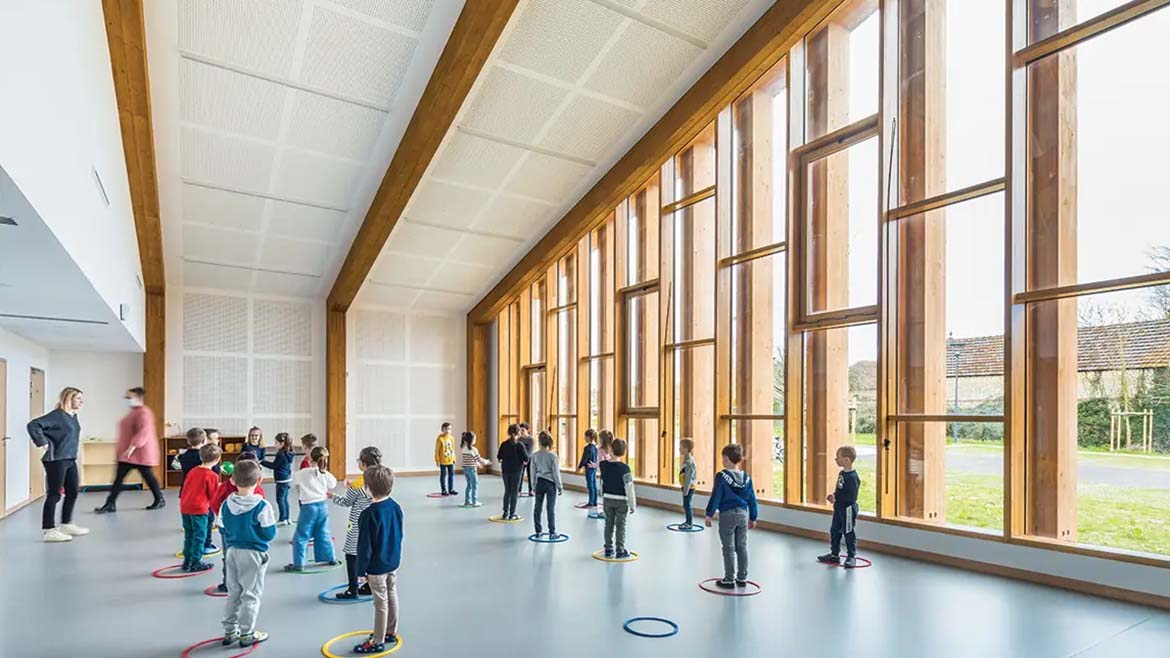
Photo © Sergio Grazia
The École Les Coteaux Fleuris.
Andrés Jaque Takes an Unconventional Approach to Design and Construction at Madrid's Colegio Reggio Explora
BY ANDREW AYERS
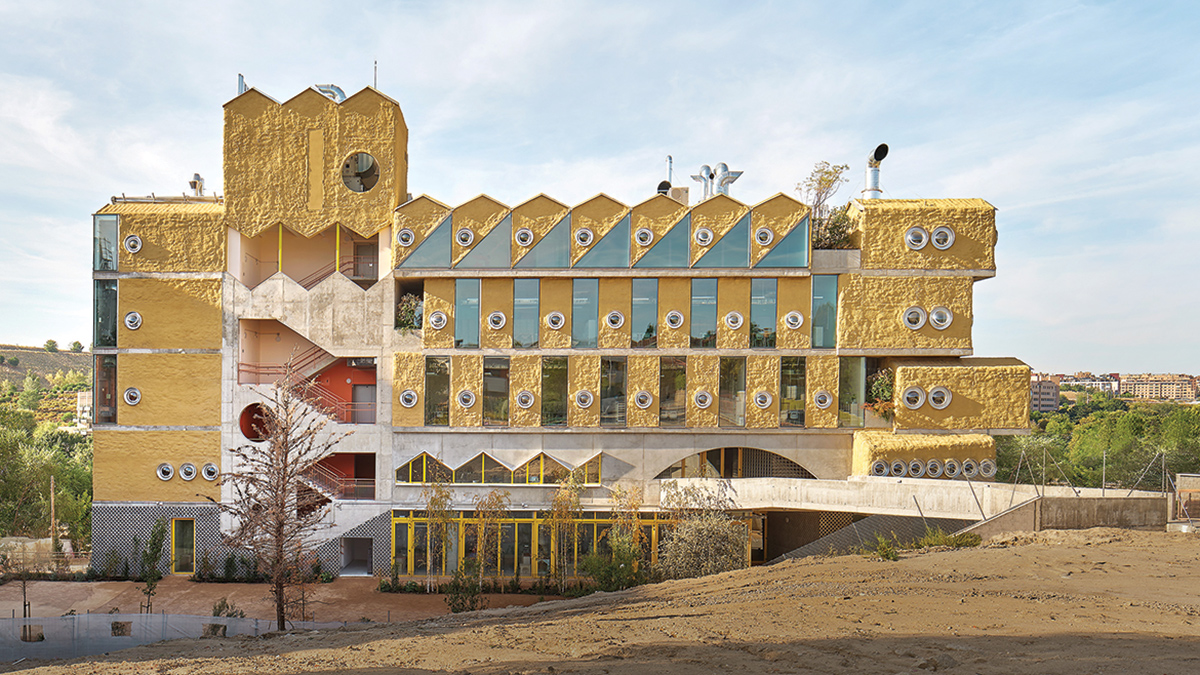
Photography by José Hevia
Colegio Reggio Explora.
“When you dream with other people, you go so much further!” laughs Eva Martín, principal of the Colegio Reggio Explora in Madrid. “It’s far better than what you could have imagined alone,” she says of the four-year “journey” she and the teachers and parents undertook to build their school with New York/Madrid-based Office for Political Innovation (OFFPOLINN)—the architecture firm founded by Andrés Jaque, the new dean of Columbia University’s Graduate School of Architecture, Planning and Preservation. Iberian pioneers of the Reggio Emilia alternative-education approach, Martín and company opened Spain’s first Reggio school in 2009, in rented accommodations, but eventually needed a purpose-built home to comply with government regulations. There was more to it than mere bureaucracy, though, since the Reggio method sees the environment as the “third teacher,” alongside adults—parents and professional educators—and other children (the impact of the social group in learning). The building in which schooling takes place is therefore of prime importance.
Since the colegio is funded privately by a group of Reggio devotees, money was tight. Eleven miles north of central Madrid, where land is cheaper, the modest rectangular site, adrift in a middle-class suburban jumble, is linked to the street by a long, narrow driveway. “School buildings are often low-lying, spread-out affairs,” says Jaque, “but that wouldn’t have been efficient or cost-effective” in the context of the $9.1 million construction budget. Instead the colegio takes the form of a compact five-story block, with playgrounds in simple rammed earth out front and back. “One thing we liked about the location is its proximity to a network of parks running up the Castellana, Madrid’s main north–south axis,” says Jaque. This is partly what prompted OFFPOLINN to locate the school’s main entrance and “public” spaces—the library and the double-height sports/assembly hall—on level two, in what they describe as a piano nobile. Inspired by Veneto villas, this elevated floor looks out over the trees, connecting the viewer to the wider ecosystem. As in a castle, the main entrance is gained via a footbridge (the land slopes down from the street), and, in keeping with the idea of nobility, this part of the building, in concrete, is perched high on pilotis, and engineered as thinly as possible, thanks to an impressive series of structural arches that, Jaque says, reduced the need for steel reinforcement.
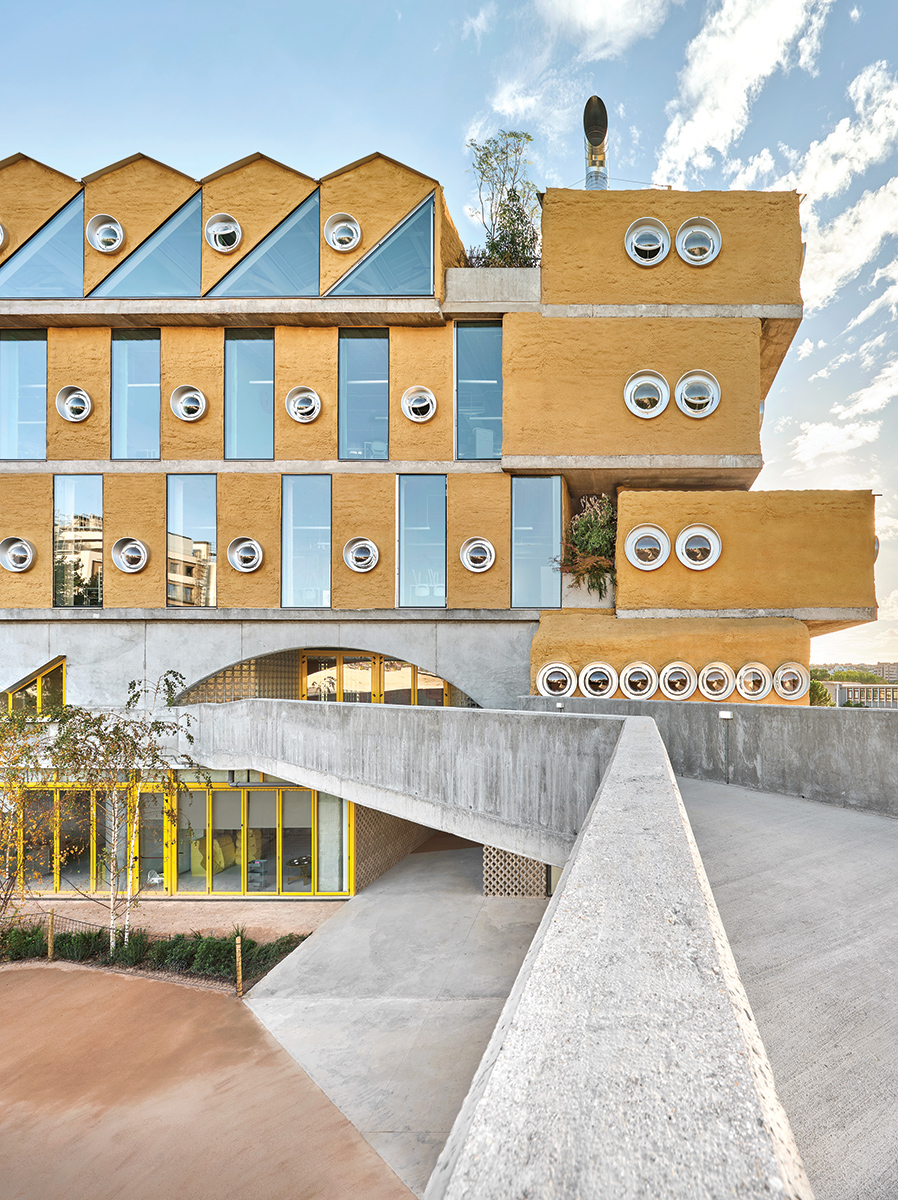
Photography by José Hevia
Yellow cork insulation is sprayed onto the external envelope. Polycarbonate bubble porthole windows add to the building’s unconventional appearance.
Again in the interests of economy, the envelope is in lightweight perforated brick, while the upper levels are constructed from a steel frame with thin concrete floor slabs, some parts taking the form of what the architects term casitas—“little houses”—intended to bring a village feel to these areas of the school. Generous glazing panels allow abundant light into the building, while natural ventilation is provided via countless polycarbonate bubble portholes that contribute to the colegio’s distinctly eccentric appearance. “We wanted the children to adopt it like a pet,” says Jaque, “a sort of Hello Kitty look.” For 9-year-old Nuria, quoted on the Colegio Reggio’s Facebook page, her school “looks like a robot made of butter,” a reference to the yellow cork insulation sprayed in several layers onto the external envelope over the brick. Developed by OFFPOLINN, this sustainable technique encourages biodiversity, since it is intended to weather like the tree bark it once was, gathering moss, lichen, and other forms of non-human life. Likewise, tiny recessed gardens set into the school’s facades are intended to attract birds, butterflies, and bats, increasing the building’s “third teacher” potential.
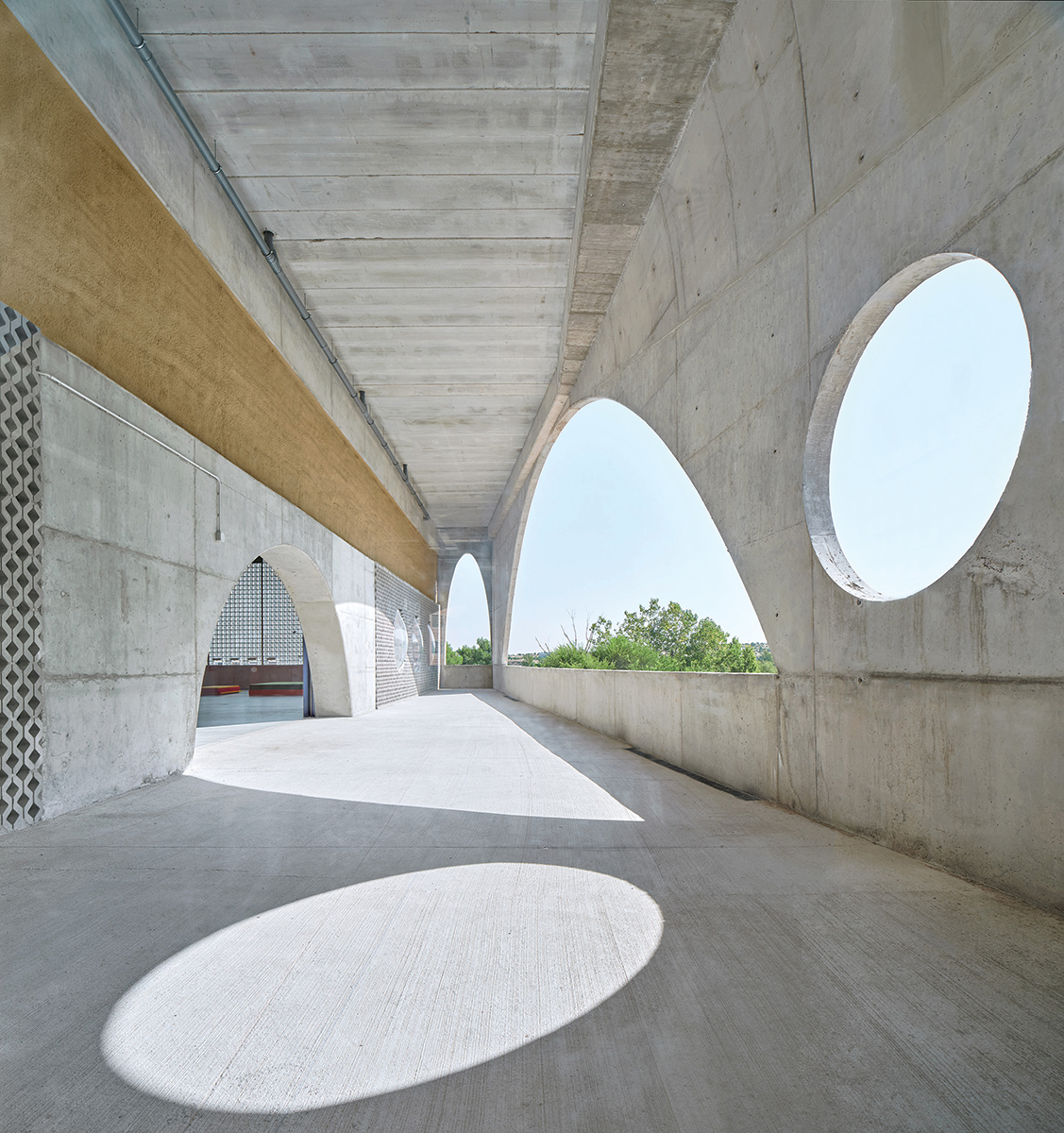
Photography by José Hevia
The building features a series of structural arches and triangular cutouts in the envelope.
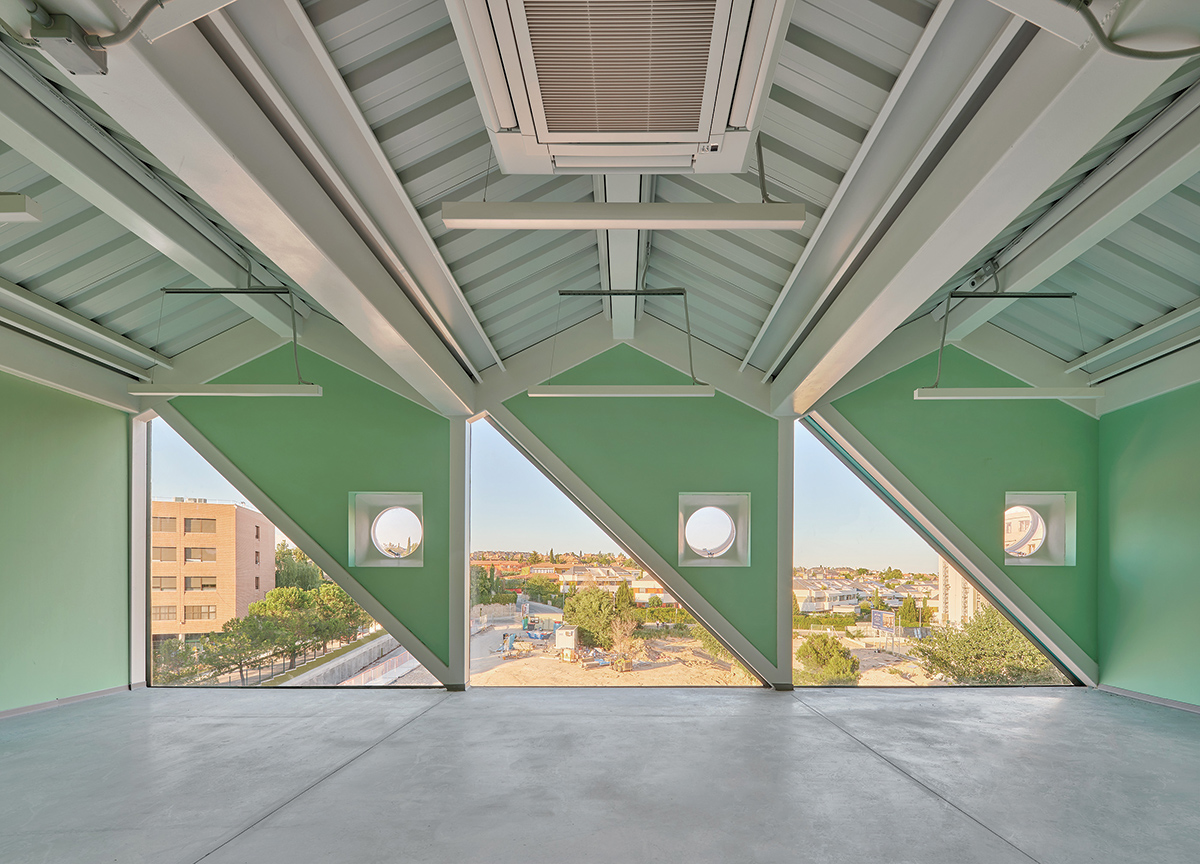
Photography by José Hevia
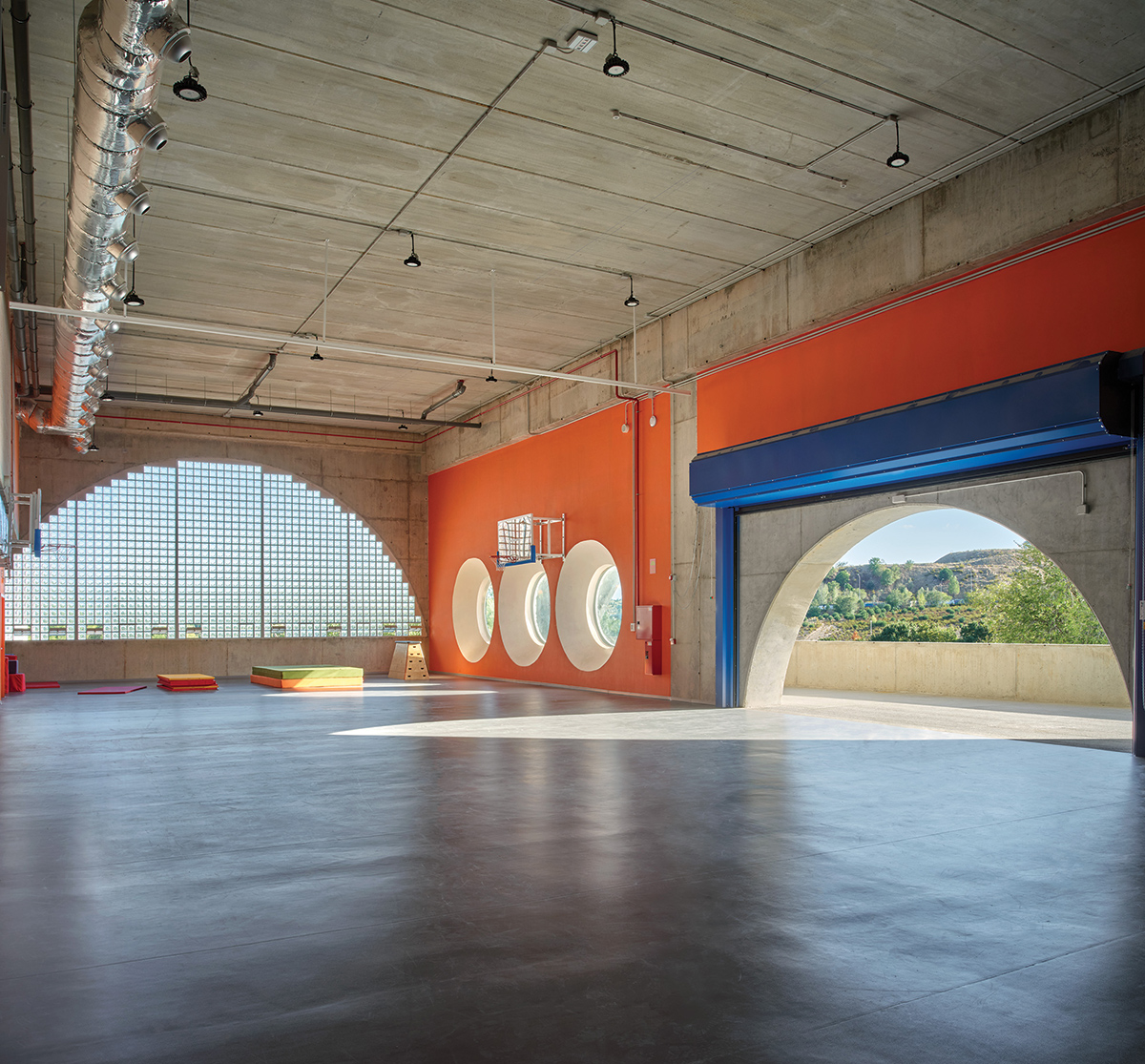
Photography by José Hevia
“Children come here as babies and leave when they’re 17 or 18. We felt they should go on a journey as they progress through the school,” says Jaque of the decision to organize the building in strata according to age. The youngest pupils are on the ground floor, their classrooms opening on to the front playground and also the dining room (since toddlers’ parents often spend time with them at the school, they can use the dining room as a workplace). On level two, the library opens on a terrace from which the rear playground can be reached via a concrete stair—“We wanted to allow outdoor reading, but also to be inclusive, with a recreation space for bookish children who aren’t so into games,” explains Jaque—while the sports/assembly hall enjoys a generous open-air loggia. Middle-school children occupy part of level two and all of level three, while the oldest are up top, their two floors organized around a double-height tree-filled atrium, realized using “agricultural infrastructure that we optimized in a Lacaton & Vassal kind of way,” says Jaque. Looking out toward the towers of Madrid’s business district on level five, three interconnecting laboratories—chemistry, physics, and biology—symbolically place senior students in the wider context of science, economics, society, and the world at large.
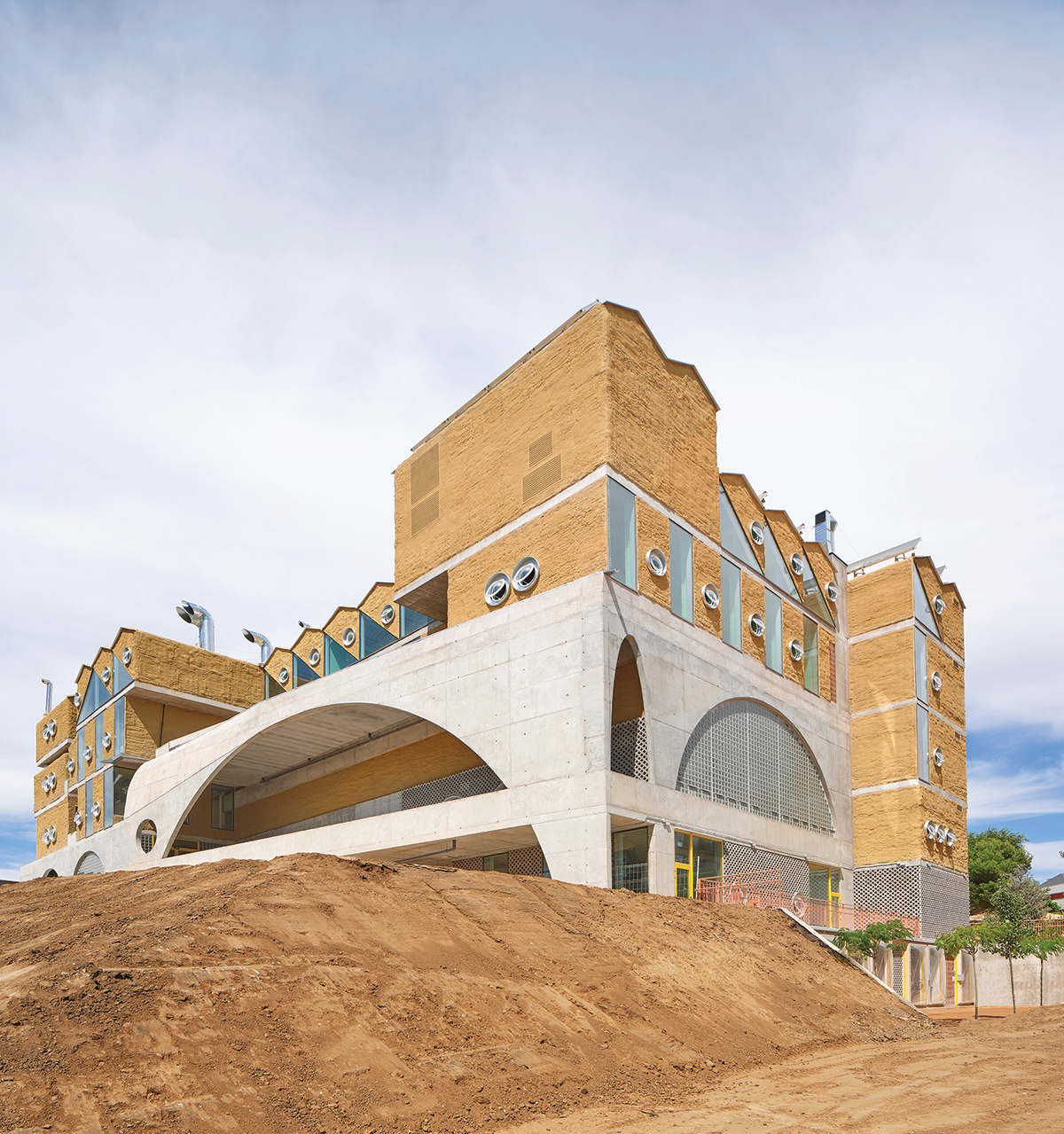
Photography by José Hevia
The five-story stack is arranged around children’s ages. The building features a series of structural arches and triangular cutouts in the envelope.
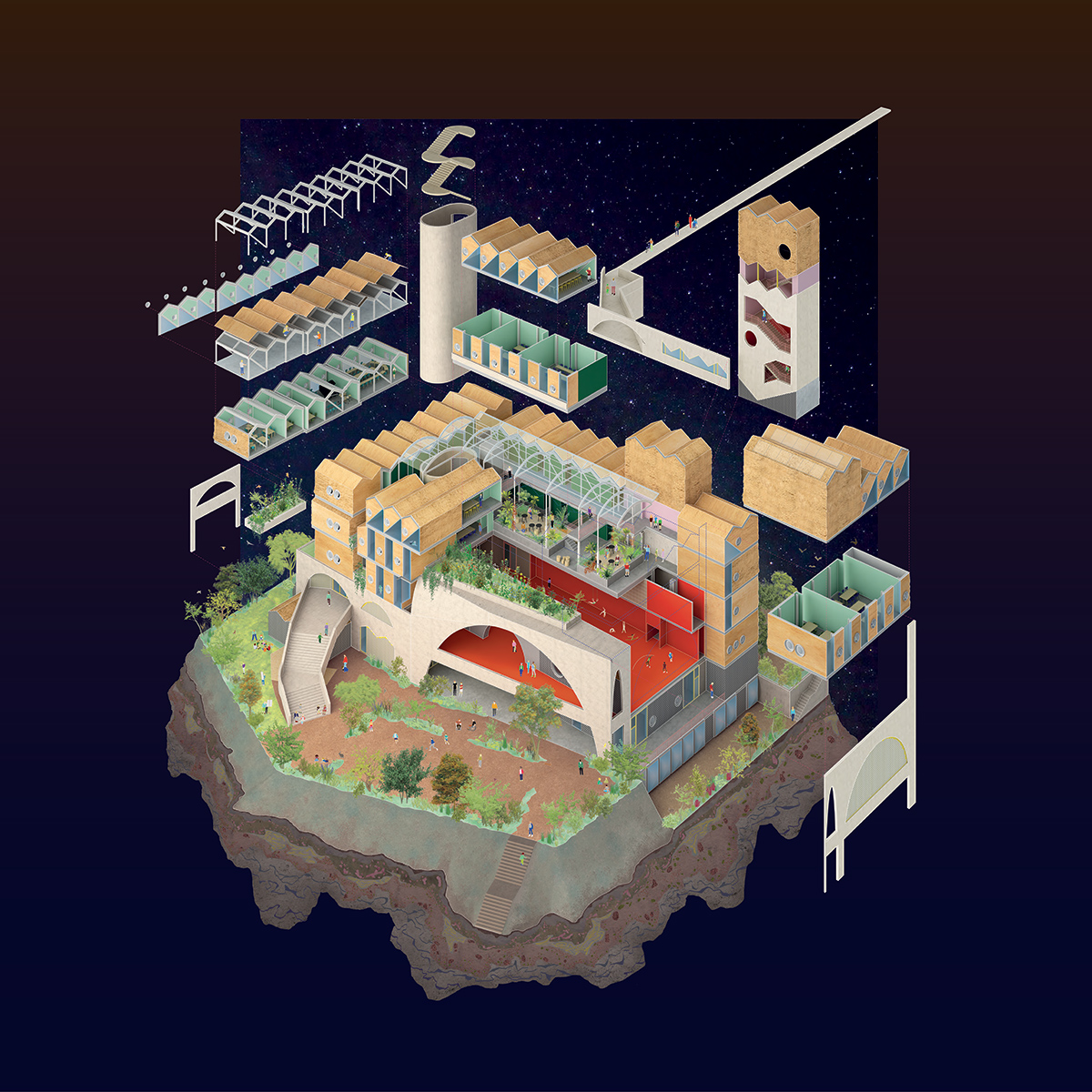
Photography by José Hevia
Inside, structure, wiring, and mechanical heating and ventilation systems (there is no air-conditioning) are entirely exposed. “One reason we left everything naked was the limited budget,” explains Jaque. “But we also wanted an unfinished building that would be perceived as living and would evolve. Then there were the science teachers, who felt the innards that are usually hidden would make for a good teaching aid.” If the school looks like an anthropomorphic factory, it’s no accident, for besides studying monasteries, Palladian villas, and James Stirling’s Oxbridge colleges, OFFPOLINN also had Japanese Metabolism and Alejandro de la Sota’s airy, luminous Clesa dairy plant in mind. Inside, with all the ducting revealed, this biological-industrial image is yet further reinforced. While these days we’re used to exposed technics à la Centre Pompidou, architects usually seek to aestheticize them; here, however, where ceilings groan with ducts, piping snakes everywhere, and lumpy fireproofed columns block the way, the result is sometimes ugly, and even oppressive in certain circulation areas. Though it’s clearly deliberate—an informal aesthetic of raw truth whose unintimidating mess can stand whatever is thrown at it—one wonders what design lessons children will take away. Anything goes? A reactionary retreat into hyper-minimalism?
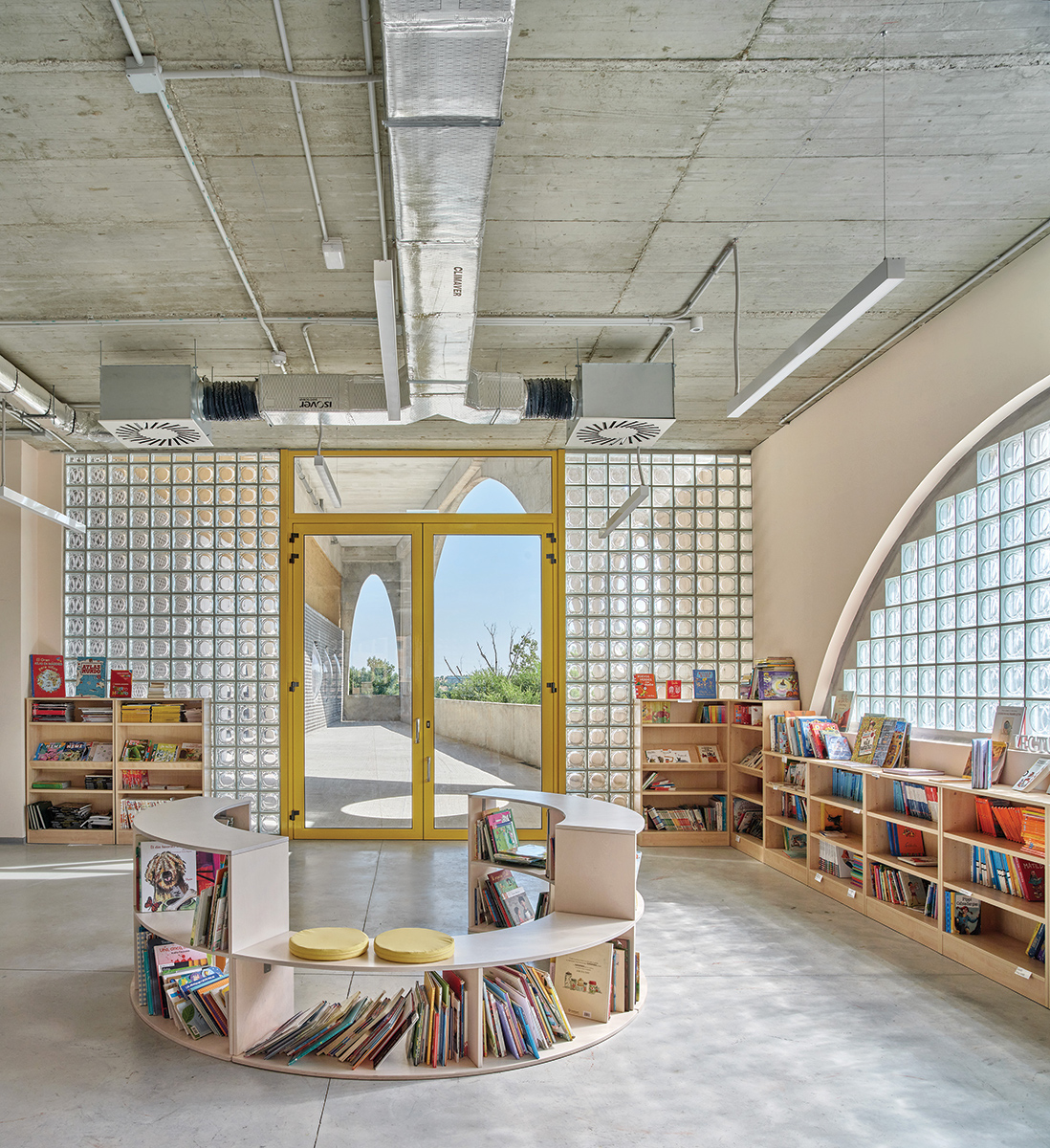
Photography by José Hevia
Throughout the building, piping and ductwork is exposed. As a counterpoint, the spaces have abundant daylight and lots of color and plantings.

Photography by José Hevia
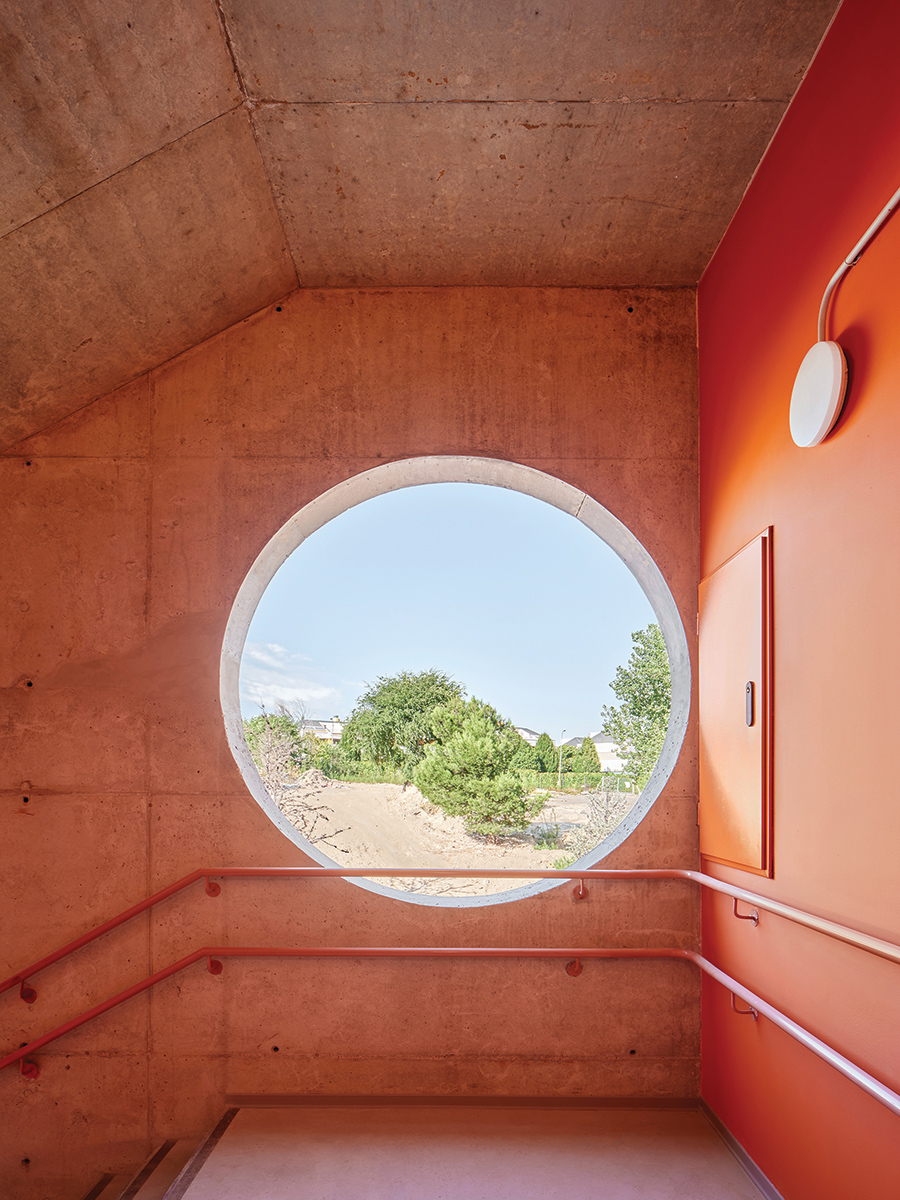
Photography by José Hevia
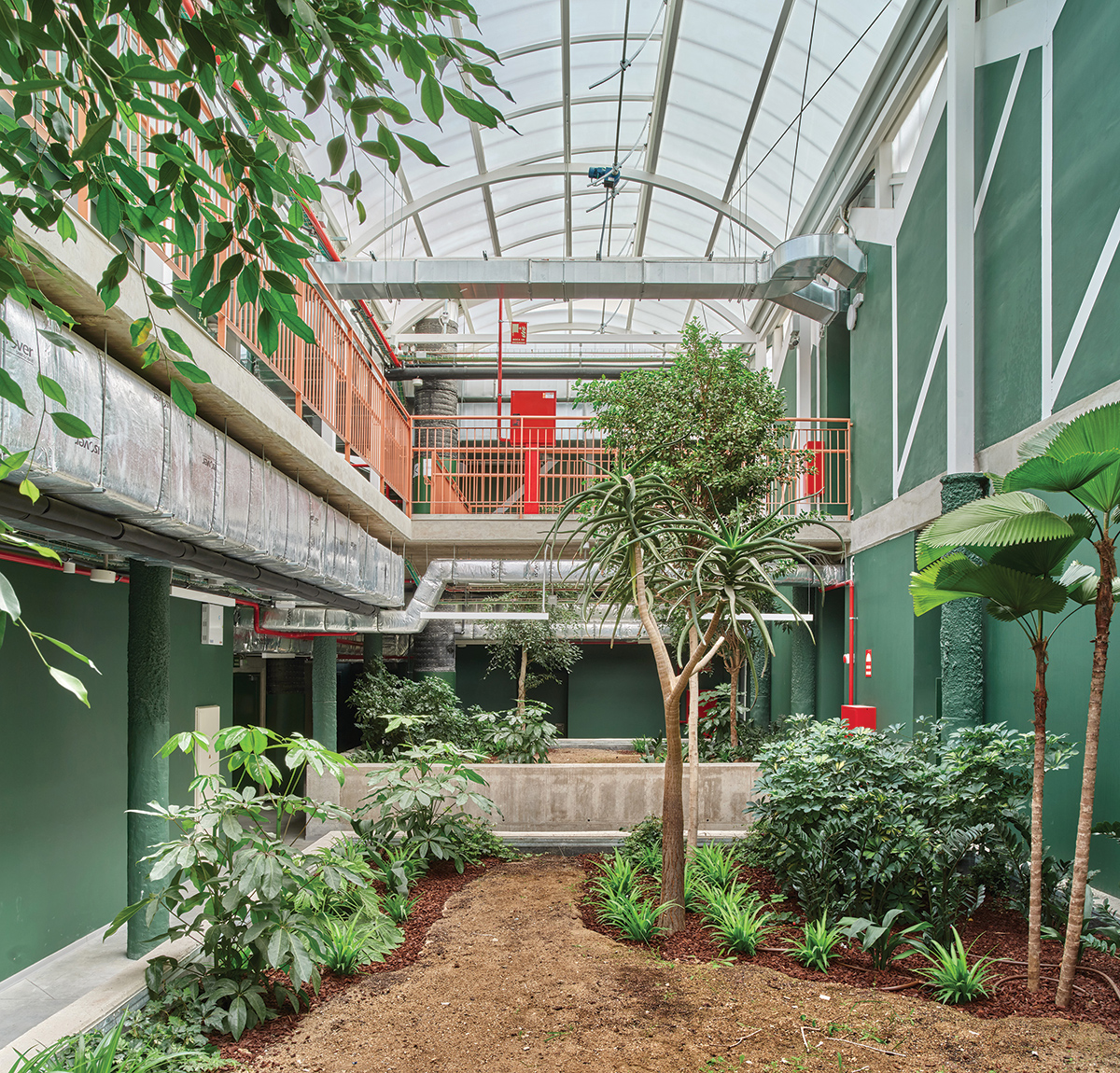
Photography by José Hevia
At any rate, the way this late-Modernist cliché has been made to feel radical again demonstrates how, in keeping with OFFPOLINN’s name, building the Colegio Reggio was a fundamentally political act. “Educa-tion in Spain has traditionally been the preserve of the Catholic Church,” explains Jaque, “which used it as a means for social control. The Spanish Civil War was partly about that.” With democracy, he says, nothing changed: rather than constructing a public education system, the government funded private schools, leaving the Catholic hegemony intact. “The Reggio system offers an alternative,” he continues, “a nonreligious education that encourages social innovation and seeks to develop children’s personal capacities and identities, giving them the agency to define their place in society.” For Martín, who remembers being hit by the nuns at her all-girls’ school, it’s about doing “what’s best for the children and not for the adults” to produce well-adjusted members of society. It will be 15 years before the youngest children complete their entire schooling in this jolly “Willy Wonka” building, and only then will we know how this utopian experiment has turned out.
Credits
ARCHITECT: Office for Political Innovation — Andrés Jaque, principal; Roberto González García, Luis González Cabrera, Alberto Heras, Ismael Medina Manzano, Jesús Meseguer Cortés, Paola Pardo-Castillo, Rajvi Anandpara, Juan David Barreto, Inês Barros, Ludovica Battista, Shubhankar Bhajekar, Elise Durand, Drishti Gandhi, Maria Karagianni, Bansi Mehta, Alessandro Peja, Meeerati Rana, Mishti Shah, Saumil Shanghavi, design team
ARCHITECT OF RECORD:
ADAMA Arquitectos Técnicos — Ángel David Moreno Casero
ENGINEERS: Qube Ingeniería de Estructuras (structural);
JG Ingenieros (m/e/p)
CONSULTANTS: Mingobasarrate (soil and ecology); Dirtec Arquitectos Técnicos (survey)
CLIENT: Colegio Reggio Explora
SIZE: 72,150 square feet
COST: $9.1 million
COMPLETION DATE: October 2022
View course on architecturalrecord.com »
This month's Building Type Study combines with the CEU to showcase a range of creative early-childhood through high-school learning environments—from sustainable buildings-as-teaching-tools in Spain and California, to modular timber structures in rural France designed to connect and grow, and multi use athletic facilities on urban campuses in New York and Bogotá.

Photo © Sergio Grazia
The École Les Coteaux Fleuris.
Andrés Jaque Takes an Unconventional Approach to Design and Construction at Madrid's Colegio Reggio Explora
BY ANDREW AYERS

Photography by José Hevia
Colegio Reggio Explora.
“When you dream with other people, you go so much further!” laughs Eva Martín, principal of the Colegio Reggio Explora in Madrid. “It’s far better than what you could have imagined alone,” she says of the four-year “journey” she and the teachers and parents undertook to build their school with New York/Madrid-based Office for Political Innovation (OFFPOLINN)—the architecture firm founded by Andrés Jaque, the new dean of Columbia University’s Graduate School of Architecture, Planning and Preservation. Iberian pioneers of the Reggio Emilia alternative-education approach, Martín and company opened Spain’s first Reggio school in 2009, in rented accommodations, but eventually needed a purpose-built home to comply with government regulations. There was more to it than mere bureaucracy, though, since the Reggio method sees the environment as the “third teacher,” alongside adults—parents and professional educators—and other children (the impact of the social group in learning). The building in which schooling takes place is therefore of prime importance.
Since the colegio is funded privately by a group of Reggio devotees, money was tight. Eleven miles north of central Madrid, where land is cheaper, the modest rectangular site, adrift in a middle-class suburban jumble, is linked to the street by a long, narrow driveway. “School buildings are often low-lying, spread-out affairs,” says Jaque, “but that wouldn’t have been efficient or cost-effective” in the context of the $9.1 million construction budget. Instead the colegio takes the form of a compact five-story block, with playgrounds in simple rammed earth out front and back. “One thing we liked about the location is its proximity to a network of parks running up the Castellana, Madrid’s main north–south axis,” says Jaque. This is partly what prompted OFFPOLINN to locate the school’s main entrance and “public” spaces—the library and the double-height sports/assembly hall—on level two, in what they describe as a piano nobile. Inspired by Veneto villas, this elevated floor looks out over the trees, connecting the viewer to the wider ecosystem. As in a castle, the main entrance is gained via a footbridge (the land slopes down from the street), and, in keeping with the idea of nobility, this part of the building, in concrete, is perched high on pilotis, and engineered as thinly as possible, thanks to an impressive series of structural arches that, Jaque says, reduced the need for steel reinforcement.

Photography by José Hevia
Yellow cork insulation is sprayed onto the external envelope. Polycarbonate bubble porthole windows add to the building’s unconventional appearance.
Again in the interests of economy, the envelope is in lightweight perforated brick, while the upper levels are constructed from a steel frame with thin concrete floor slabs, some parts taking the form of what the architects term casitas—“little houses”—intended to bring a village feel to these areas of the school. Generous glazing panels allow abundant light into the building, while natural ventilation is provided via countless polycarbonate bubble portholes that contribute to the colegio’s distinctly eccentric appearance. “We wanted the children to adopt it like a pet,” says Jaque, “a sort of Hello Kitty look.” For 9-year-old Nuria, quoted on the Colegio Reggio’s Facebook page, her school “looks like a robot made of butter,” a reference to the yellow cork insulation sprayed in several layers onto the external envelope over the brick. Developed by OFFPOLINN, this sustainable technique encourages biodiversity, since it is intended to weather like the tree bark it once was, gathering moss, lichen, and other forms of non-human life. Likewise, tiny recessed gardens set into the school’s facades are intended to attract birds, butterflies, and bats, increasing the building’s “third teacher” potential.

Photography by José Hevia
The building features a series of structural arches and triangular cutouts in the envelope.

Photography by José Hevia

Photography by José Hevia
“Children come here as babies and leave when they’re 17 or 18. We felt they should go on a journey as they progress through the school,” says Jaque of the decision to organize the building in strata according to age. The youngest pupils are on the ground floor, their classrooms opening on to the front playground and also the dining room (since toddlers’ parents often spend time with them at the school, they can use the dining room as a workplace). On level two, the library opens on a terrace from which the rear playground can be reached via a concrete stair—“We wanted to allow outdoor reading, but also to be inclusive, with a recreation space for bookish children who aren’t so into games,” explains Jaque—while the sports/assembly hall enjoys a generous open-air loggia. Middle-school children occupy part of level two and all of level three, while the oldest are up top, their two floors organized around a double-height tree-filled atrium, realized using “agricultural infrastructure that we optimized in a Lacaton & Vassal kind of way,” says Jaque. Looking out toward the towers of Madrid’s business district on level five, three interconnecting laboratories—chemistry, physics, and biology—symbolically place senior students in the wider context of science, economics, society, and the world at large.

Photography by José Hevia
The five-story stack is arranged around children’s ages. The building features a series of structural arches and triangular cutouts in the envelope.

Photography by José Hevia
Inside, structure, wiring, and mechanical heating and ventilation systems (there is no air-conditioning) are entirely exposed. “One reason we left everything naked was the limited budget,” explains Jaque. “But we also wanted an unfinished building that would be perceived as living and would evolve. Then there were the science teachers, who felt the innards that are usually hidden would make for a good teaching aid.” If the school looks like an anthropomorphic factory, it’s no accident, for besides studying monasteries, Palladian villas, and James Stirling’s Oxbridge colleges, OFFPOLINN also had Japanese Metabolism and Alejandro de la Sota’s airy, luminous Clesa dairy plant in mind. Inside, with all the ducting revealed, this biological-industrial image is yet further reinforced. While these days we’re used to exposed technics à la Centre Pompidou, architects usually seek to aestheticize them; here, however, where ceilings groan with ducts, piping snakes everywhere, and lumpy fireproofed columns block the way, the result is sometimes ugly, and even oppressive in certain circulation areas. Though it’s clearly deliberate—an informal aesthetic of raw truth whose unintimidating mess can stand whatever is thrown at it—one wonders what design lessons children will take away. Anything goes? A reactionary retreat into hyper-minimalism?

Photography by José Hevia
Throughout the building, piping and ductwork is exposed. As a counterpoint, the spaces have abundant daylight and lots of color and plantings.

Photography by José Hevia

Photography by José Hevia

Photography by José Hevia
At any rate, the way this late-Modernist cliché has been made to feel radical again demonstrates how, in keeping with OFFPOLINN’s name, building the Colegio Reggio was a fundamentally political act. “Educa-tion in Spain has traditionally been the preserve of the Catholic Church,” explains Jaque, “which used it as a means for social control. The Spanish Civil War was partly about that.” With democracy, he says, nothing changed: rather than constructing a public education system, the government funded private schools, leaving the Catholic hegemony intact. “The Reggio system offers an alternative,” he continues, “a nonreligious education that encourages social innovation and seeks to develop children’s personal capacities and identities, giving them the agency to define their place in society.” For Martín, who remembers being hit by the nuns at her all-girls’ school, it’s about doing “what’s best for the children and not for the adults” to produce well-adjusted members of society. It will be 15 years before the youngest children complete their entire schooling in this jolly “Willy Wonka” building, and only then will we know how this utopian experiment has turned out.
Credits
ARCHITECT: Office for Political Innovation — Andrés Jaque, principal; Roberto González García, Luis González Cabrera, Alberto Heras, Ismael Medina Manzano, Jesús Meseguer Cortés, Paola Pardo-Castillo, Rajvi Anandpara, Juan David Barreto, Inês Barros, Ludovica Battista, Shubhankar Bhajekar, Elise Durand, Drishti Gandhi, Maria Karagianni, Bansi Mehta, Alessandro Peja, Meeerati Rana, Mishti Shah, Saumil Shanghavi, design team
ARCHITECT OF RECORD:
ADAMA Arquitectos Técnicos — Ángel David Moreno Casero
ENGINEERS: Qube Ingeniería de Estructuras (structural);
JG Ingenieros (m/e/p)
CONSULTANTS: Mingobasarrate (soil and ecology); Dirtec Arquitectos Técnicos (survey)
CLIENT: Colegio Reggio Explora
SIZE: 72,150 square feet
COST: $9.1 million
COMPLETION DATE: October 2022
Leddy Maytum Stacy's Science and Environmental Center Embraces its Landscape with Sustainable Goals
BY SARAH AMELAR
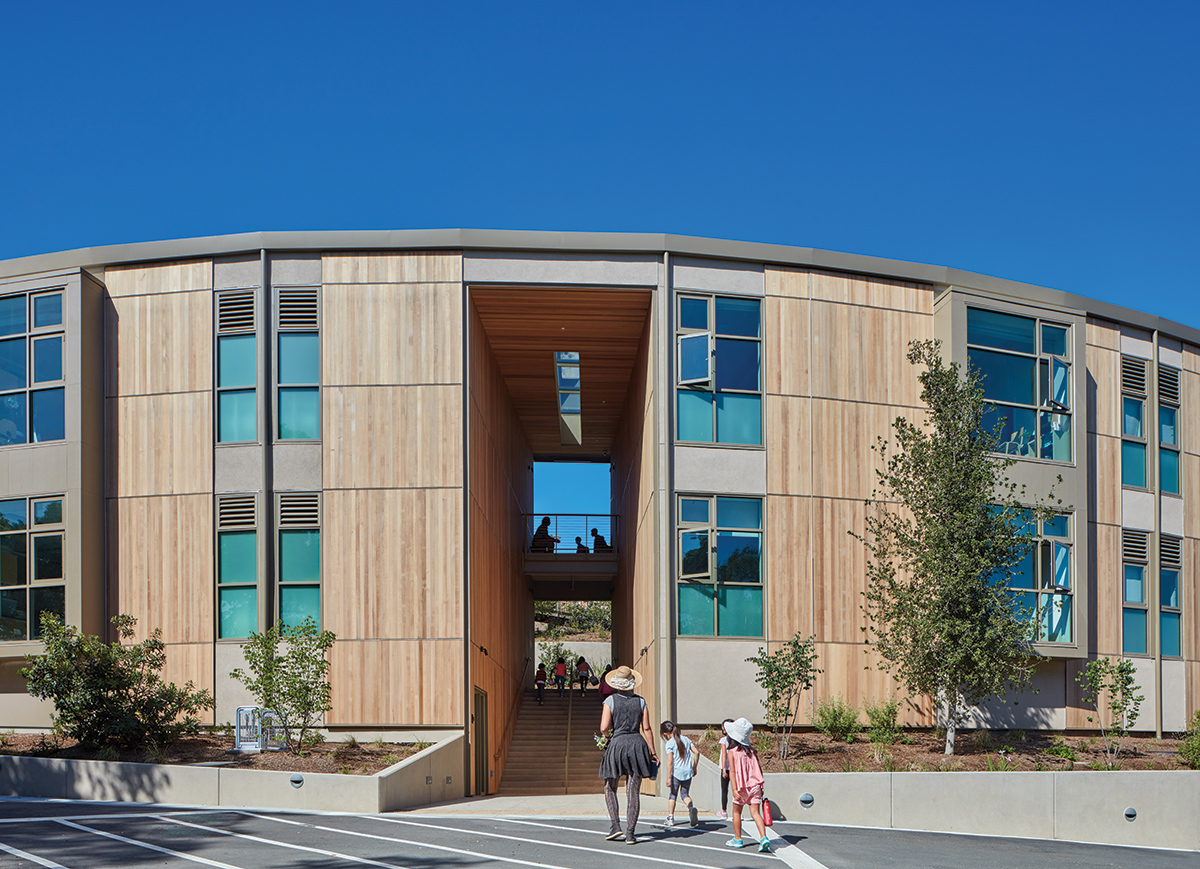
Photography by Richard Barnes
Nueva School Science and Environmental Center.
At Nueva School’s pre-K through 8th-grade campus, in Hillsborough, California, even the buildings are fodder for learning. Most recently, students have been analyzing the sustainability strategies of the new Science and Environmental Center (SEC), completed in 2021 by the San Francisco firm Leddy Maytum Stacy Architects (LMSA). It’s the latest in a series of projects by LMSA for this independent school’s hilly, wooded 33-acre compound. Joining forces since 2004—on works including a library, classroom structure, revised master plan, and student center/cafeteria—Nueva and LMSA have set increasingly ambitious goals for energy performance and carbon reduction. The 11,600-square-foot SEC building is so efficient that, in warmer seasons, it produces more energy than it uses to operate. Still, “it doesn’t hit you over the head with its technological feats,” says LMSA principal William Leddy. “In our view, the poetics and experience of place—the way daylight moves, casting shadows through leafy canopies or slatted screens—are just as important as technical aspects in achieving sustainability.”
Deferring to the existing undulant terrain, with its coastal live oaks and olive grove, LMSA has built along a hillside and a ridge overlooking San Francisco Bay. The meandering campus occupies land once owned by banker William Willard Crocker, whose mansion, a 1931 Italianate villa, now houses the lower school. (Founded in 1967, with an ongoing focus on intellectually curious, high-aptitude learners, Nueva added a separate, LMSA-designed high school campus in 2014, in nearby San Mateo.) The emphasis on imaginative indoor-outdoor learning and respectful stewardship of the planet are reflected in the architecture. For example, LMSA’s 2007 student center/cafeteria offers—beneath a planted roof—a large, flexible multipurpose space, with a wide south-facing garage door that opens to a dining terrace and landscape-embedded amphitheater. In addition to the new SEC, this most recent phase expanded the student center and its kitchen, bumping out the structure’s bowed north elevation to include a long, arcing balcony with panoramic bay views. Between the two buildings, LMSA created a “Canopy Walkway” amid the trees. Elevated on piers (and fully ADA compliant), it recalls boardwalks on stilts that weave gently through rainforests, barely touching the land.
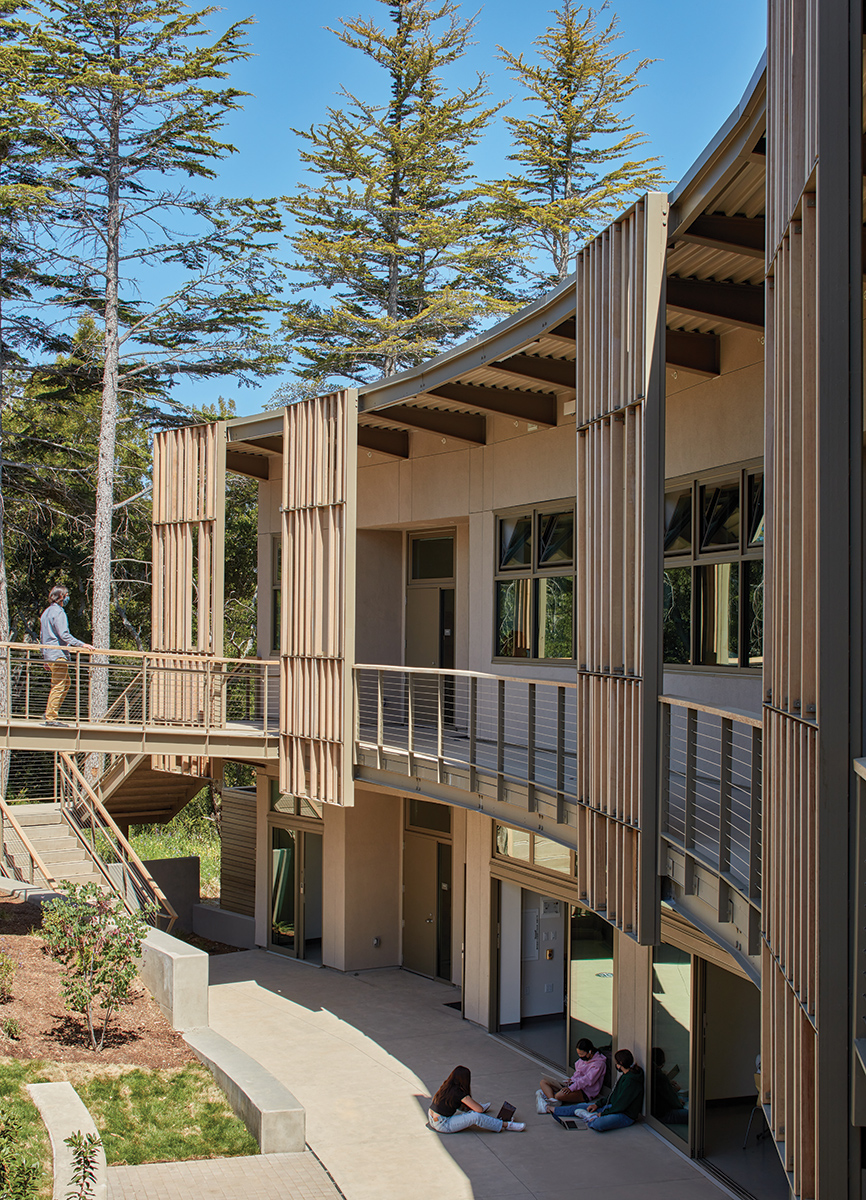
Photography by Richard Barnes
FSC-certified red cedar cladding (top of page) and slatted timber brise-soleils (above) are compatible with the SEC’s forest setting.
Visually and experientially compatible with the forest setting, timber cladding and slatted brise-soleils (all FCS-certified) tie together much of LMSA’s work here, including the SEC’s red cedar exterior. The wood helps keep the project’s embodied energy and carbon low. But, given the campus’s location along a wildland-urban interface, the architects took extra precautions, planting fire-resistant native vegetation and integrating noncombustible steel and low-carbon concrete structural systems, interior sprinklers, and a one-hour fire-rated exterior skin assembly, achieved with gypsum board beneath the wood sheathing. Echoing the student center’s bowed face, the SEC building has a curved bar configuration. Split by an outdoor concrete stairway that follows the downward slope, this form becomes a gateway to wilder, densely forested open space—a preserve where students play, design and construct treehouses, grow vegetables, and study ecosystems.
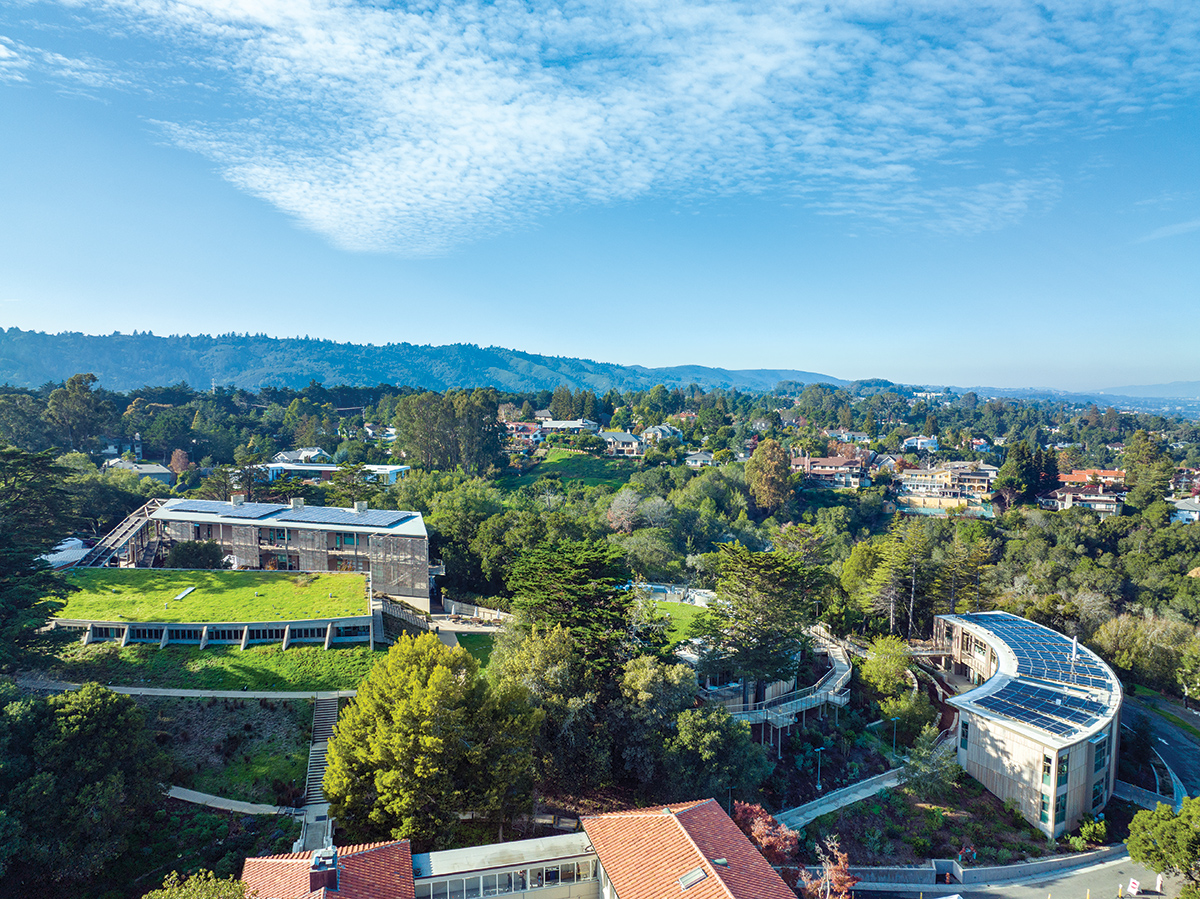
Photography by Richard Barnes
The building'scurves are in sync with the landscape and campus (above), to which it connects via catwalk and bridge (below).
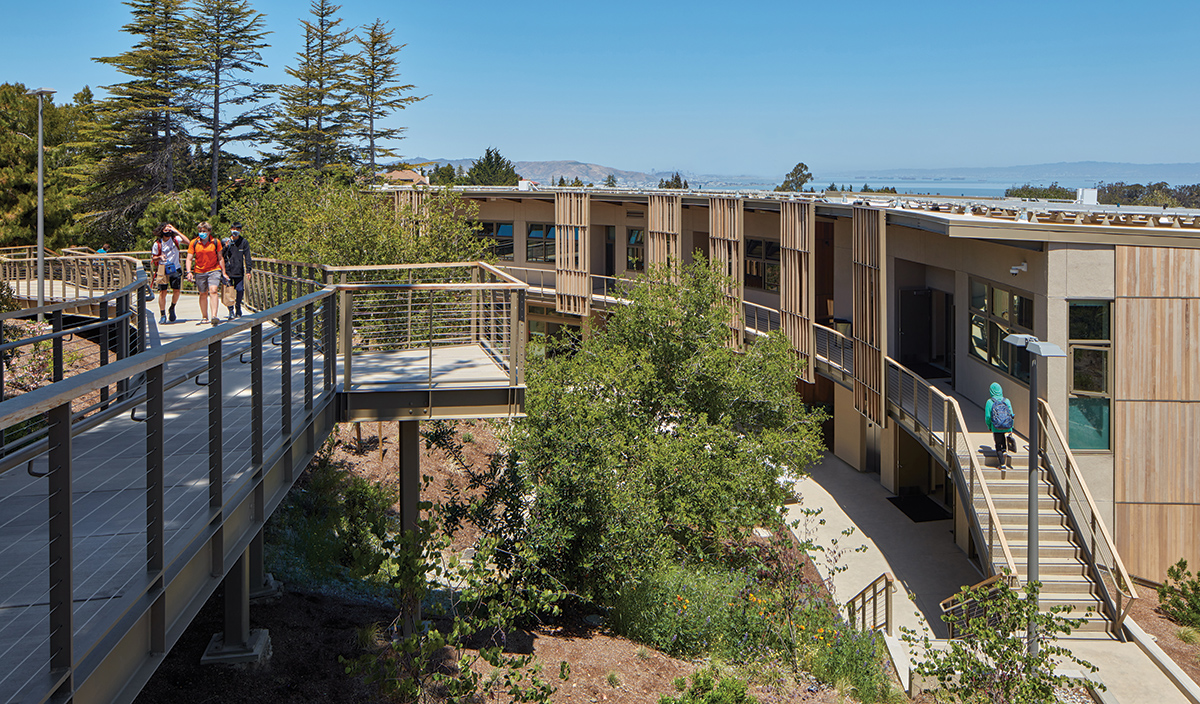
Photography by Richard Barnes
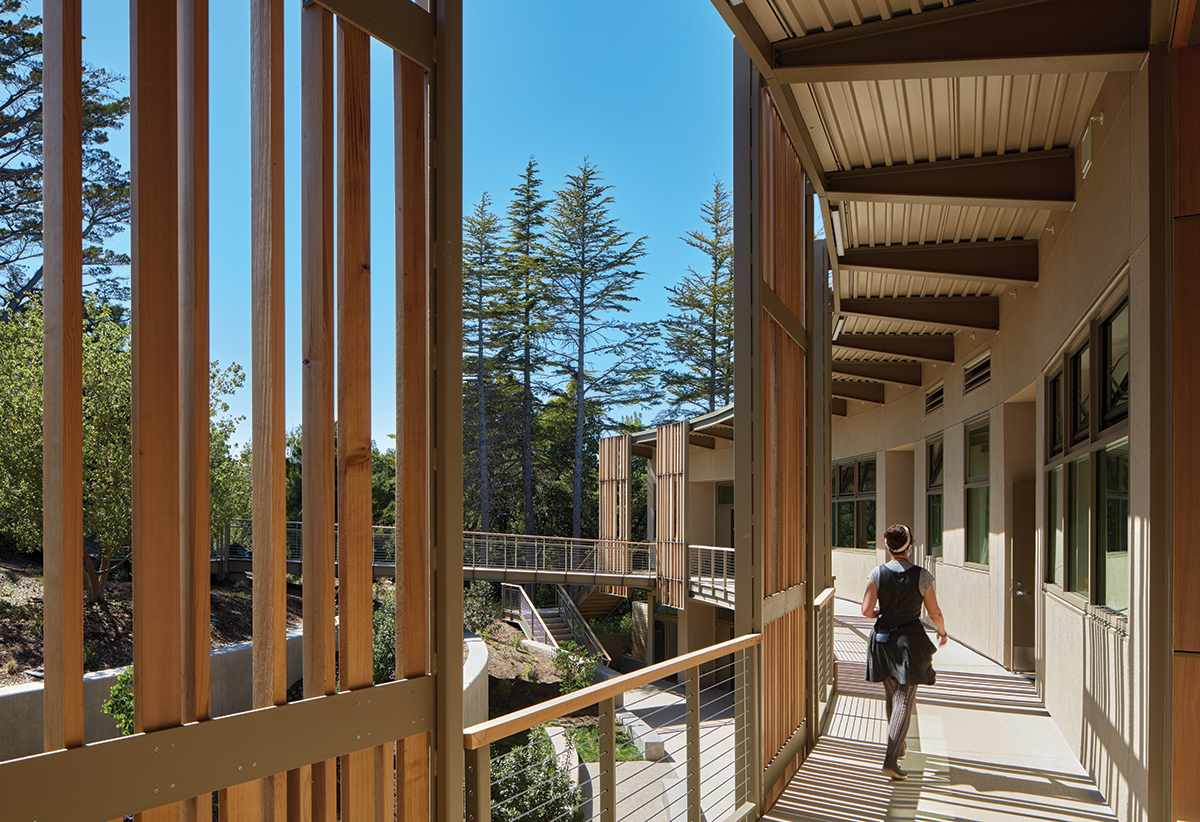
Photography by Richard Barnes
Part of Nueva’s credo is “learn by doing,” and broad sliding doors along SEC’s south elevation support that approach, allowing classroom and lab activities to spill outdoors. “Many of the ways we achieve sustainability are simple, low-tech, and passive,” says Leddy. “The building is essentially one-classroom deep, allowing for cross-ventilation, shading, and views—some of the bay, others into the tree canopy.” In this temperate region, outdoor circulation replaces enclosed corridors, saving on materials and climate control. Readily reconfigurable, the interiors include spooled cables overhead, enabling students (totaling around 500 on this campus) to plug in almost anywhere indoors.
Powered by a 70-kilowatt rooftop photovoltaic array, the new building is 100 percent electric. “That’s rapidly becoming the norm in California,” says LMSA project architect Jasen Bohlander. “Over 55 cities and counties here have already passed all-electric building ordinances.” The excess photovoltaic output in warm seasons—enabling the meter to run backwards—offsets consumption in cool months, when harvested photons fall short of demand. So far, the PVs have slightly outperformed the annual net zero operational-energy goal, producing more power than the building used over a 12-month period.
For classroom heating, a hybrid, multi-zoned, air-source heat-pump system provides hot water to radiant floor slabs. The system’s thermal-exchange coils and ventilation ducts can also cool fresh air, but, for now, the school is relying on natural ventilation, nighttime air flushing, and ceiling fans. Further elevating indoor air quality, the materials, finishes, and adhesives are non-VOC and formaldehyde-free.
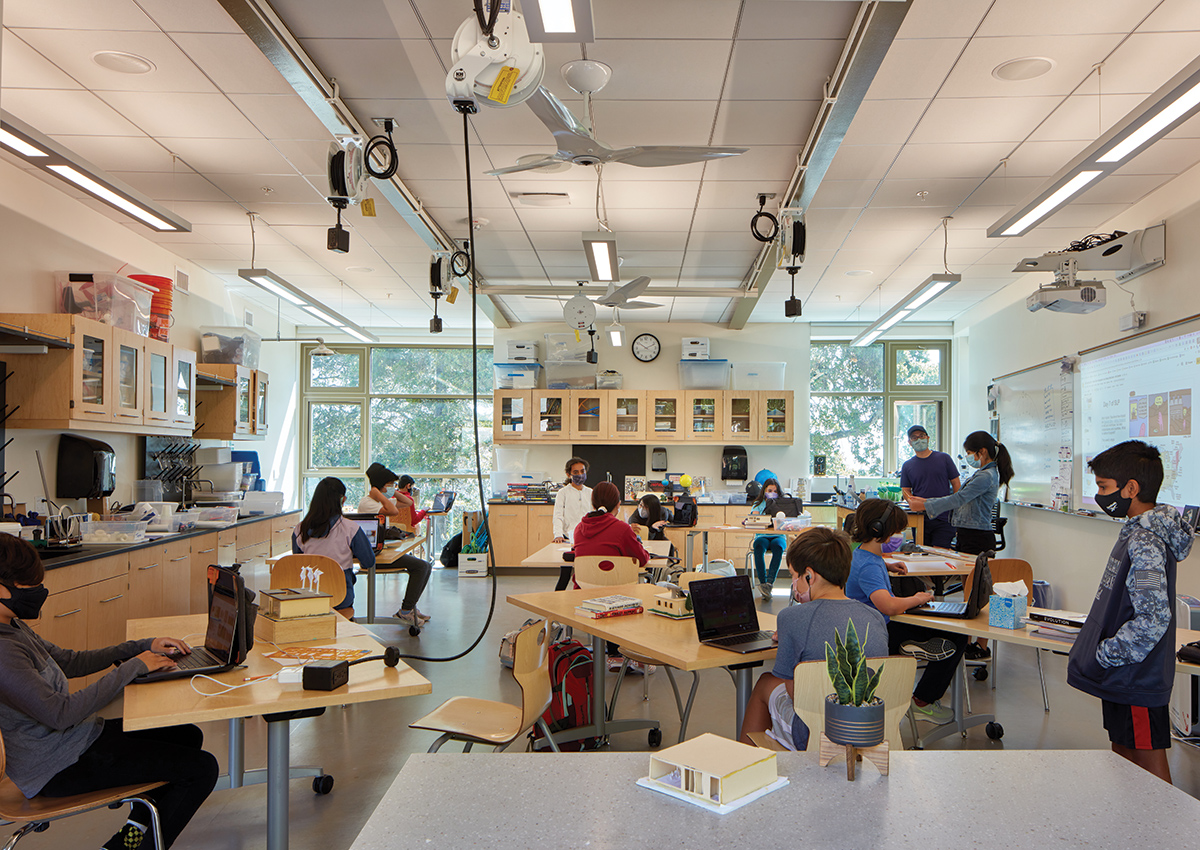
Photography by Richard Barnes
Classrooms feature non-VOC, formaldehyde-free materials, and heated floors.
LMSA, with CMG Landscape Architecture, also integrated measures to reduce water consumption in this increasingly drought-prone region. That included enhancing natural drainage routes and introducing a 10,000-gallon cistern for toilet flushing (along with ultra-efficient plumbing fixtures). As a result, the SEC has consumed 89 percent less water than typical school buildings of its size (exceeding a predicted 70 percent reduction).
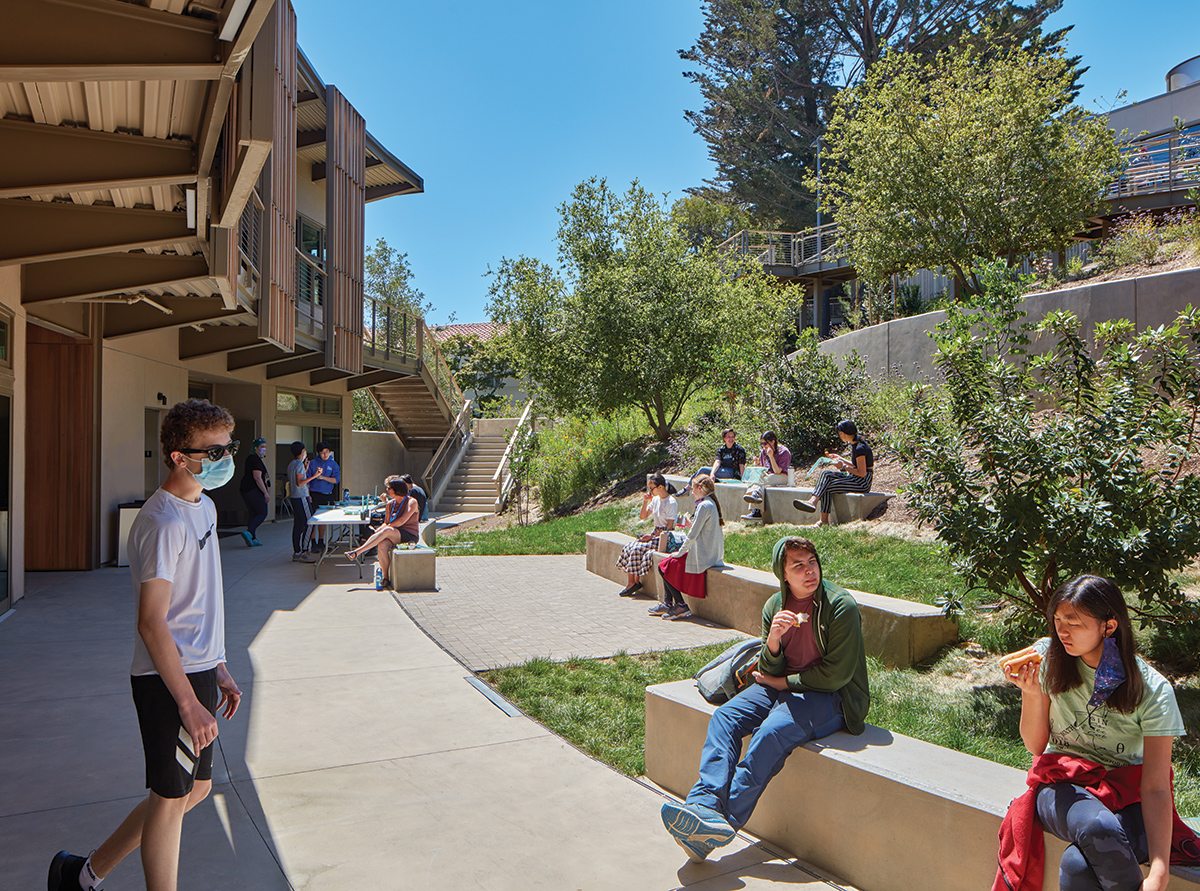
Photography by Richard Barnes
The landscape was designed to reduce water consumption and foster community.
This project not only preserved but also restored live oak woodland. Within that immersive landscape, LMSA wove outdoor spaces that encourage quiet study and informal gatherings, fostering community. On a recent visit, impromptu clusters of pupils were engaged in collaborative study on benches and in open-air nooks. “The expanded student center—now a real hub—the canopy walk, and the environmental building have seamlessly stitched together separate parts of campus, bringing together students of all ages,” says head-of-school Lee Fertig. Even mid-pandemic, the SEC’s spatial flexibility and outdoor venues—combined with its fresh-air ventilation system, which can integrate HEPA filtering—enabled it to open for classes upon completion in January 2021. That same year, the U.S. Department of Education named Nueva a Green Ribbon School for its resource efficiency, wellness attributes, and environmental curriculum.
“Developing the mindset of global and environmental citizenship has to be a top priority in education,” says Fertig. “Empowering students to nurture the place they live and learn has never been more important.” And, at Nueva, young pupils are not merely studying the ecological workings of the new architecture and landscaping—they’re also constructing scale models of sustainable buildings of their own.
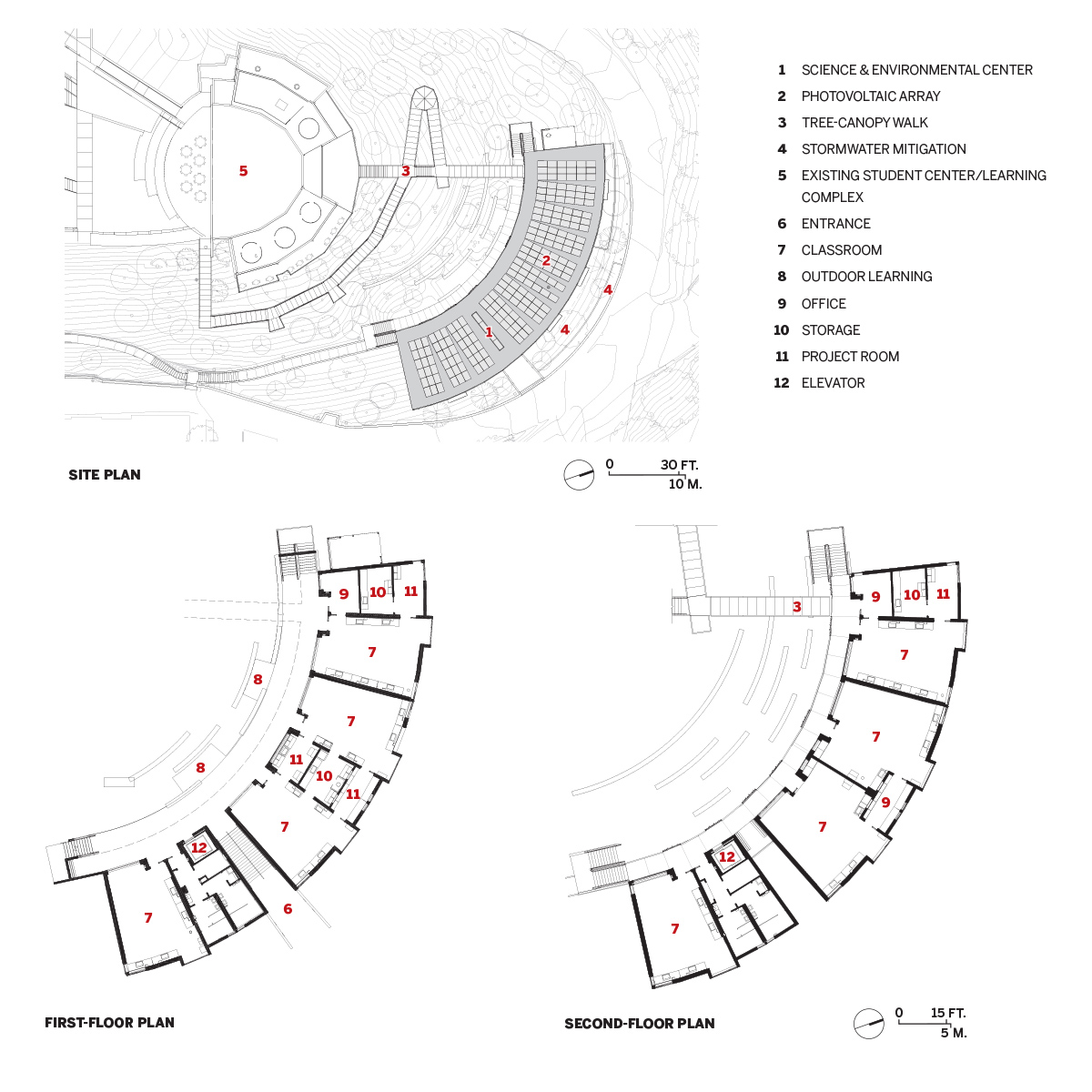
Photography by Richard Barnes
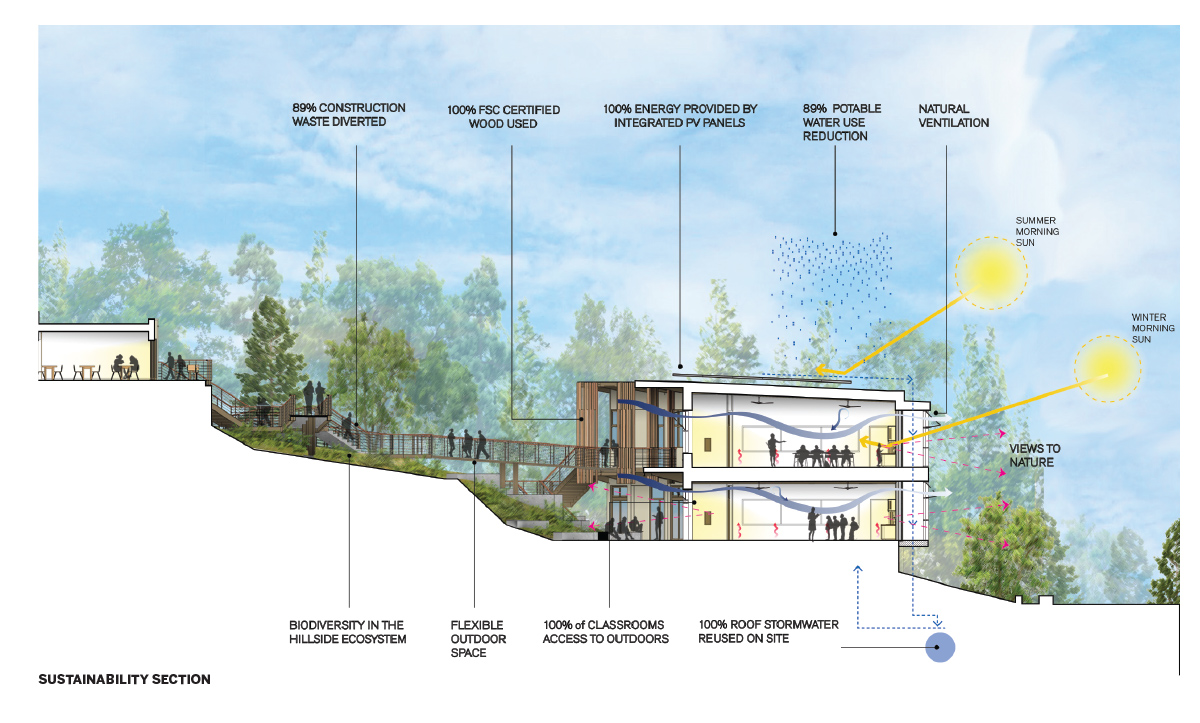
Photography by Richard Barnes
Credits
Architect: Leddy Maytum Stacy Architects — Bill Leddy, principal; Jasen Bohlander, project manager; Ian Ashcraft-Williams, project architect
Engineers: BKF(civil); Murphy Burr Curry (structural); Point Energy Innovations (m/e/p); Cupertino Electric (electrical)
Consultants: CMG (landscape architecture); UDCE (joint trench); WJE (waterproofing); Salter (acoustics); HERA (lab)
General Contractor: W.L. Butler
Client: Nueva School
Size: 11,600 square feet
Cost: withheld
Completion date: January 2021
Sources
Cladding: Western Red Cedar; Dryvit; Grace; Hardie
Roofing: GAF
Windows & Entrances: EFCO
GlaSS & Skylights: Vitro
Lighting: Finelite; BK; Wattstopper
Acoustical Ceilings: Armstrong
Paint & stains: Sherwin-Williams
Energy Management: Air Systems; SunPower (photovoltaics)
Rainwater Tank: Xerxes
Rogers Partners Changes the Game for a Private Manhattan School with an Athletic and Ecology Center
BY BETH BROOME

Photography by Albert Vecerka
The Spence School Athletic and Ecology Center’s glass curtain wall contrasts with the neighbors’ largely opaque facades and lets passersby see light and movement within the building.
What does an esteemed private school in New York’s dense confines do when it cannot accommodate all its programs in its historic building? It takes its show on the road.
In 1892, Clara Spence, a pioneering educator who believed in higher education for women, opened Miss Spence’s School for girls to prepare her pupils for college. For almost 100 years, the Spence School has occupied a Neo-Georgian edifice designed by John Russell Pope in Manhattan’s illustrious Carnegie Hill neighborhood, a stone’s throw from Central Park. Despite a recent major renovation and expansion of the building, which today houses the middle and upper schools (younger students are in a different building), Spence needed a regulation gym for the competitive play of basketball, volleyball, squash, and badminton. Other nearby private schools had found separate locations for athletic programs, and Spence, too, looked for space beyond its immediate neighborhood.
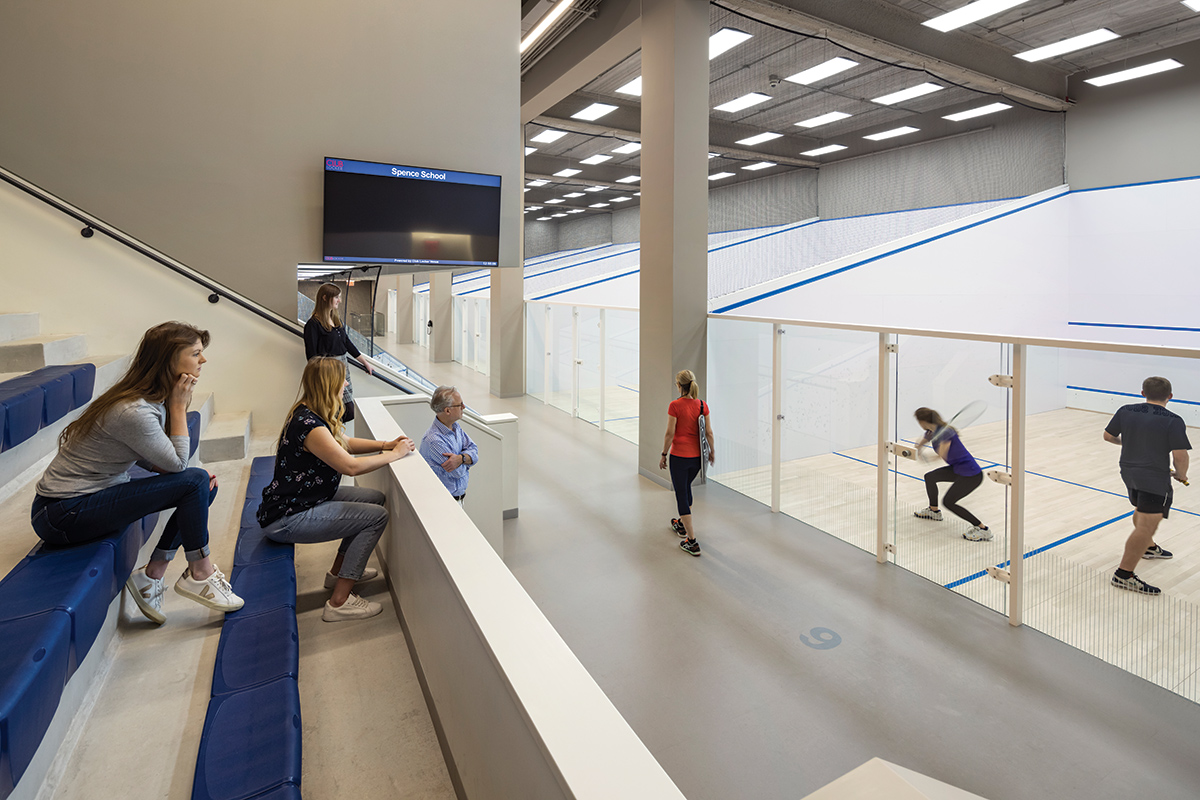
Photography by Albert Vecerka
A varied program includes nine squash courts (above), a regulation gym (below), and a large flexible space (below).
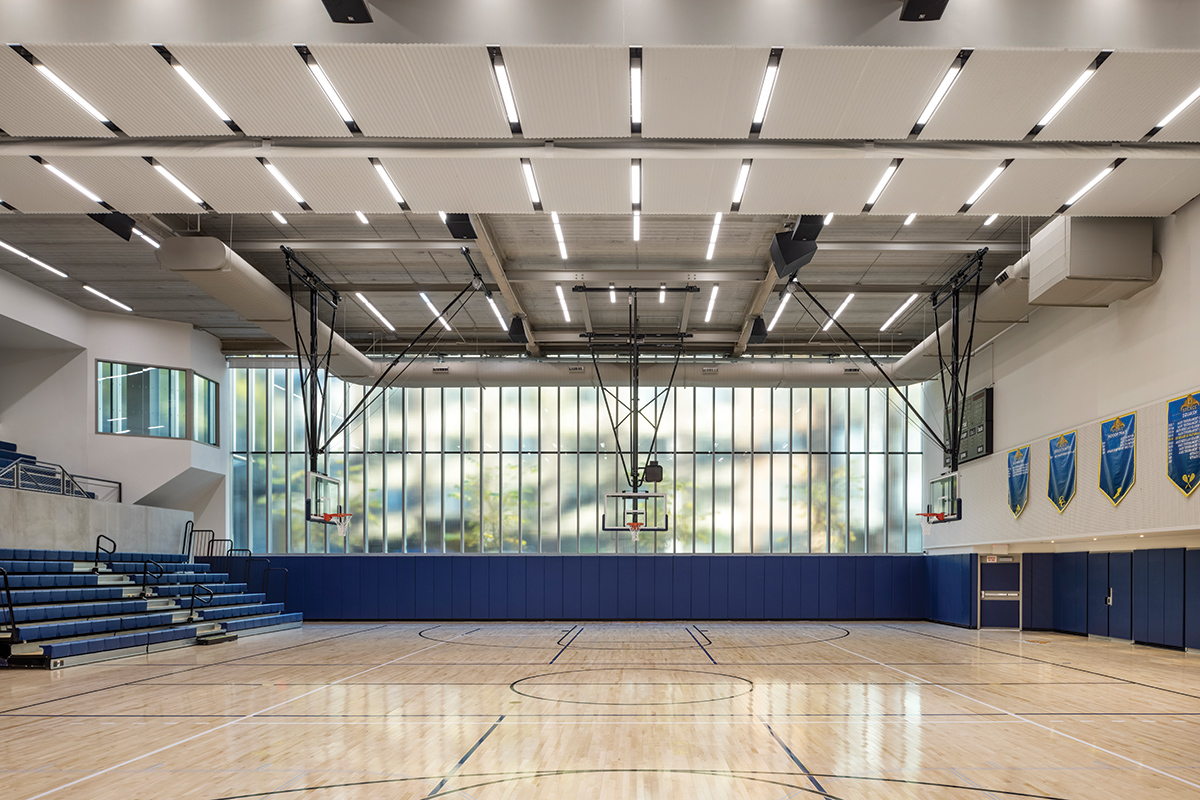
Photography by Albert Vecerka
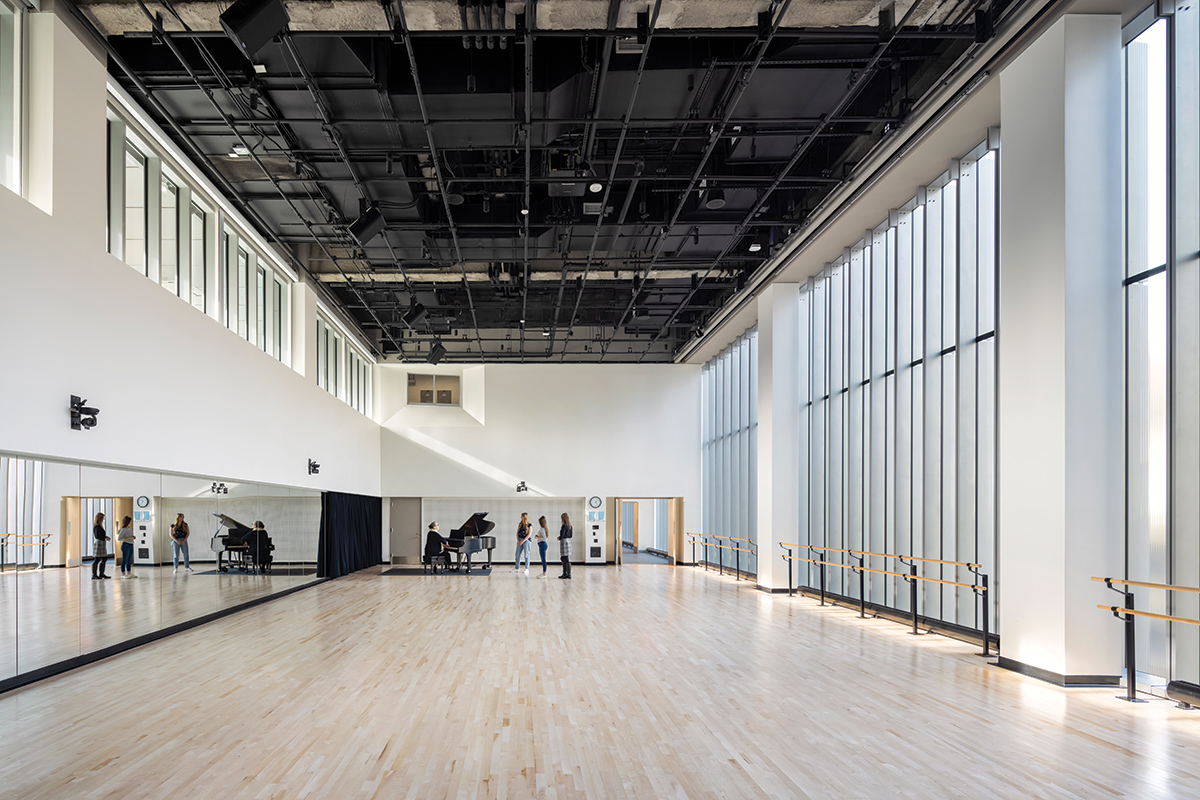
Photography by Albert Vecerka
A dozen years ago, the school purchased an old garage six blocks east in a decidedly less refined precinct of warehouses and apartment buildings. After an invited design competition, New York–based Rogers Partners began to conceptualize the new structure and how it could be more than just an athletic facility. “Holy moly!” thought Bodie Brizendine, the head of school during design and construction. “I have a site for a whole new building! Now what are we going to do?!”
Two important considerations drove the programming, says firm principal Rob Rogers. First, how do you make the facility belong to the whole student body—including the lower school—not just athletes? Second, how do you activate it throughout the day, beyond after-school team practices? “This is Manhattan real estate—it’s too valuable to not use it,” notes the architect. On the ground floor, the regulation gym not only serves Spence’s basketball and volleyball teams (regular PE classes are still held in teaching gyms in the two main buildings), but it is also used widely for competition by other private schools, as well as for PE class by two public schools. Next to and above the gym are locker rooms—even when they are empty, you feel the presence of the athletes, who have scrawled inspirational messages on the whiteboard walls. “Before a game, this place is alive!” says Coni Fichera, director of athletics. Nine squash courts—a rarity in the city—can be closed off from the rest of the building, enabling use by the outside community and, like the gym, they generate revenue from rent by other schools’ teams. On the fifth level, a multipurpose room with a sprung floor accommodates dance, theater, film, and events. And, on the top floor, an ecology center with a classroom, teaching kitchen, greenhouse, and rooftop garden serves the whole K-12 community. “It moved from being an athletic center to a beautiful building with programming all the way through,” says Brizendine.
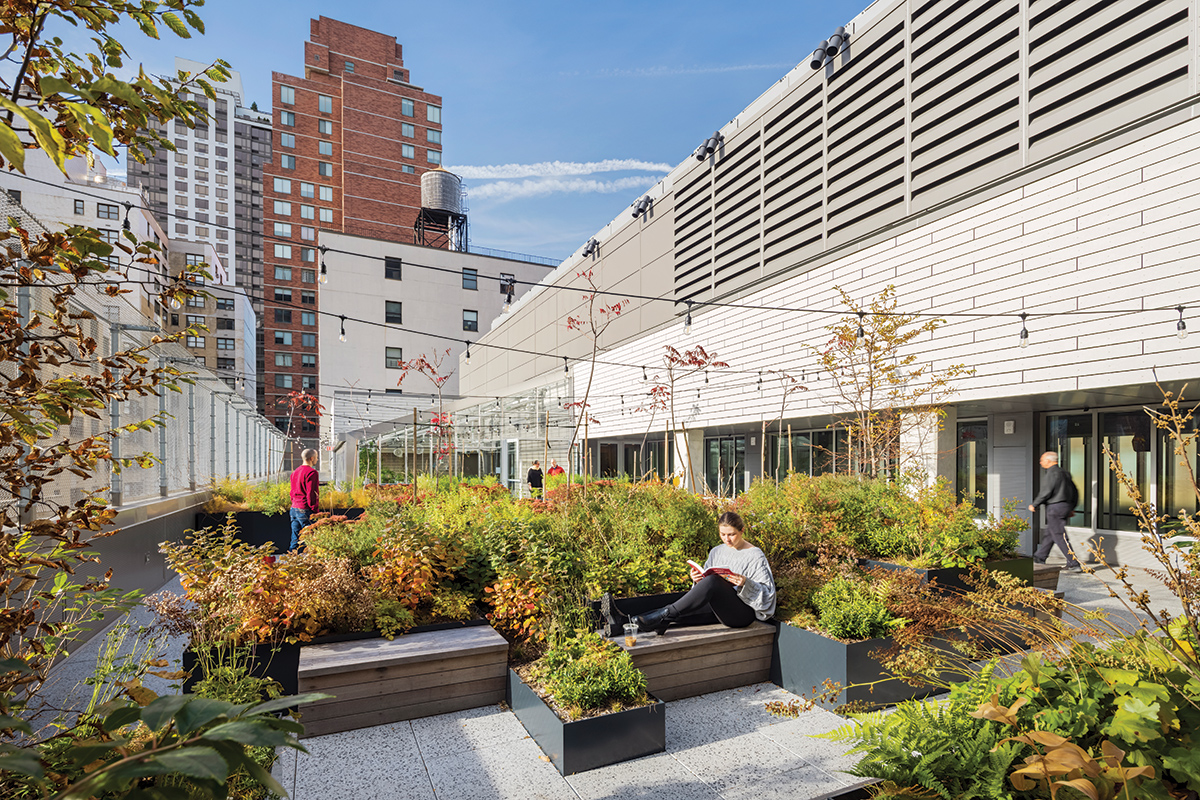
Photography by Albert Vecerka
Learning extends out onto a rooftop garden.
Fitting all this program into the constricted 59,000-square-foot city zoning envelope was like solving a jigsaw puzzle. The starting point for the internal organization was the decision to put the gym at ground level. Though more expensive than situating it on a higher floor—because of the additional structure required by a clear-span space to carry the load of the upper levels—the gym had to provide egress as a competition space that can hold more than 450 spectators. Three massive steel trusses above the ceiling eliminate the need for columns, enabling the exacting dimensions for regulation courts. Another critical decision was to stagger the squash courts sectionally across two floors—a brainstorm of the firm partner Alissa Bucher. The strategy enables the corridor leading to the courts on the fourth floor to serve as a viewing balcony overlooking the lower courts, and it also means the courts consume less volume than simple vertical stacking would. “It was a brilliant sandwich she came up with,” says Rogers. Tying it all together is a central stair, with quarter-sawn maple paneling, that winds up through the building and becomes a social connector as students and others congregate in the various common spaces surrounding it, animating the core with their activity.
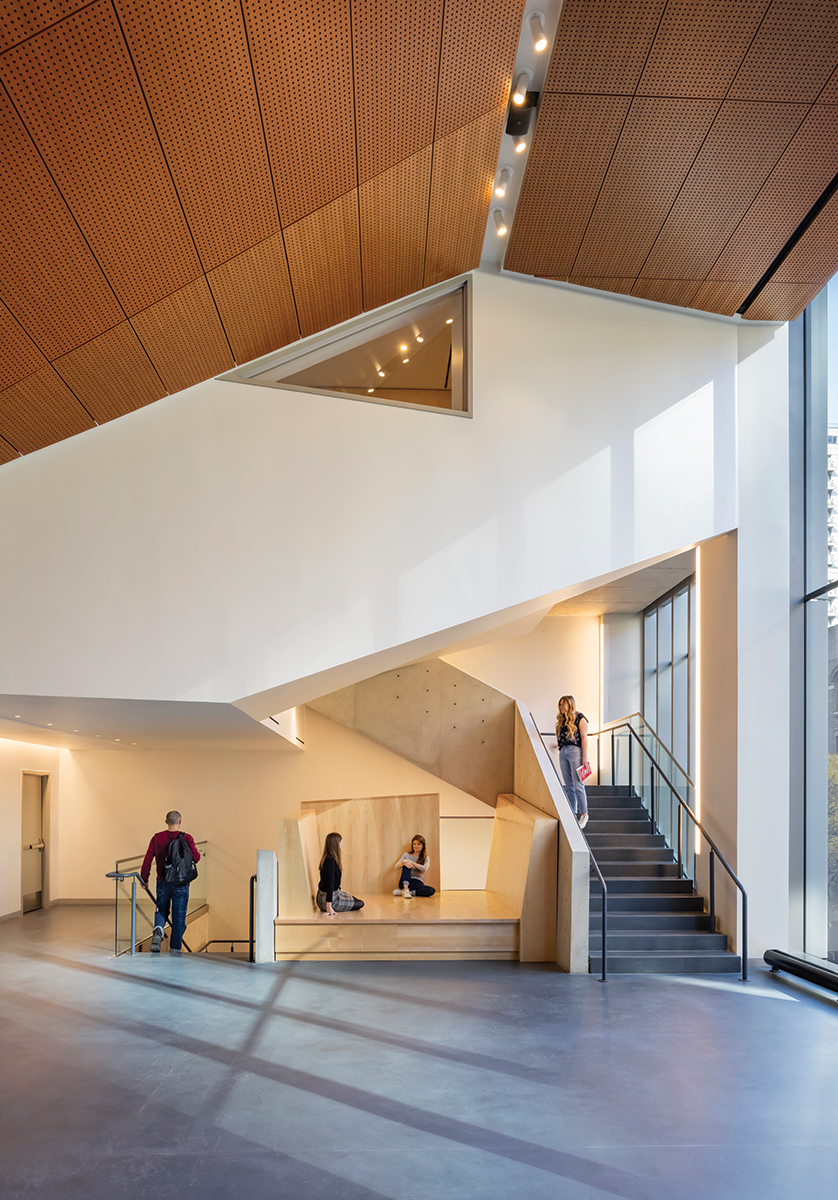
Photography by Albert Vecerka
A sculptural stair, clad in quarter-sawn maple, serves as a connector.
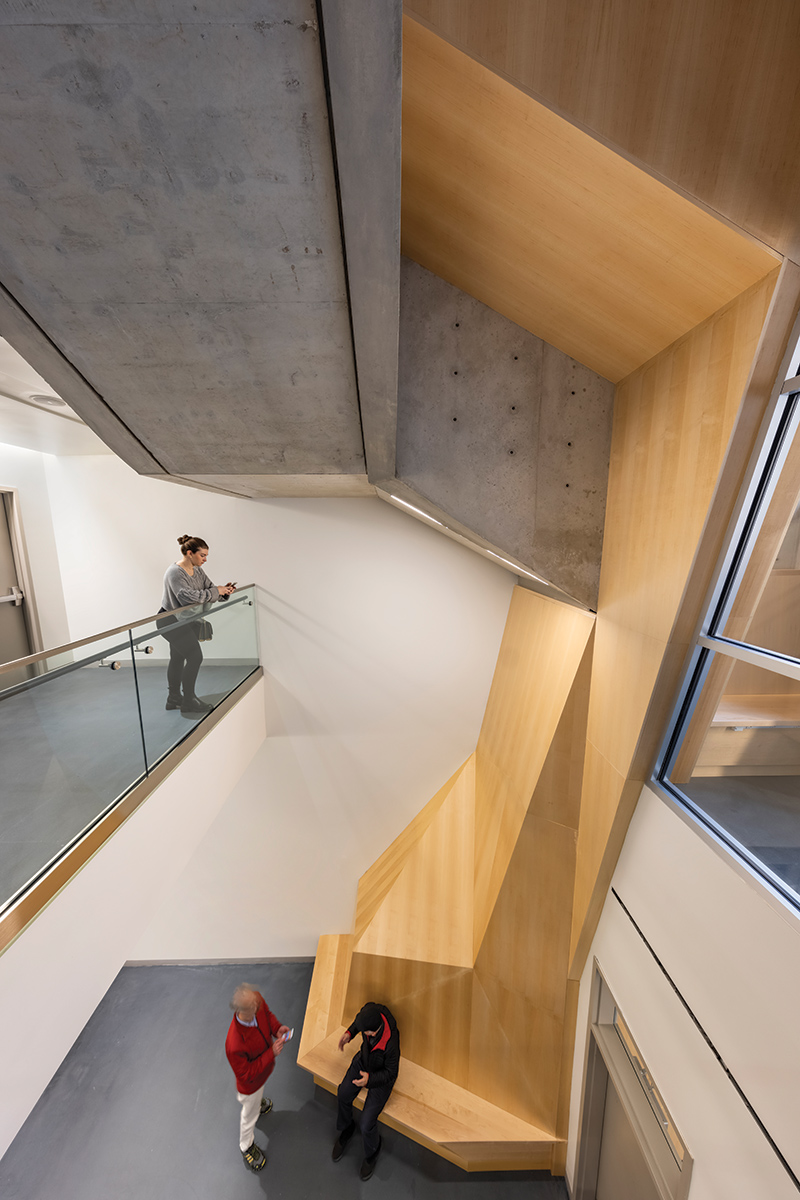
Photography by Albert Vecerka
The action inside can be read from the street, as passersby see light and movement through the largely translucent curtain wall of insulating double-laminated, patterned glass, designed with the firm Front. Game nights are particularly exciting, when hundreds of energized girls and their families fill the building with their cheers. “We want to be an active and lively neighbor, not just a big blank wall,” says Rogers, explaining that, in addition to the gym, this is where the architects spent a sizable chunk of the budget. “The rest could be a shed,” he says. The approach has paid off, presenting a handsome, welcoming face to the street.
Otherwise, the building is not about fancy materials. Throughout much of the interior—with its polished-concrete floors—gypsum board, perforated wood veneer, and other basic finishes are used on the lower portions of the walls while, above, structure, ductwork, and conduit are left exposed. It is an honest approach that is fitting.
On a crisp morning recently, the thumping of basketballs filled the air as third graders from a nearby school played in the gym. Diffuse daylight streamed onto the courts, and gathering spaces buzzed with the activity of a teachers’ professional-development meeting. Soon, the Spence volleyball team would arrive for practice. Says Brizendine, “It’s the community center we wanted it to be.”

Photography by Albert Vecerka
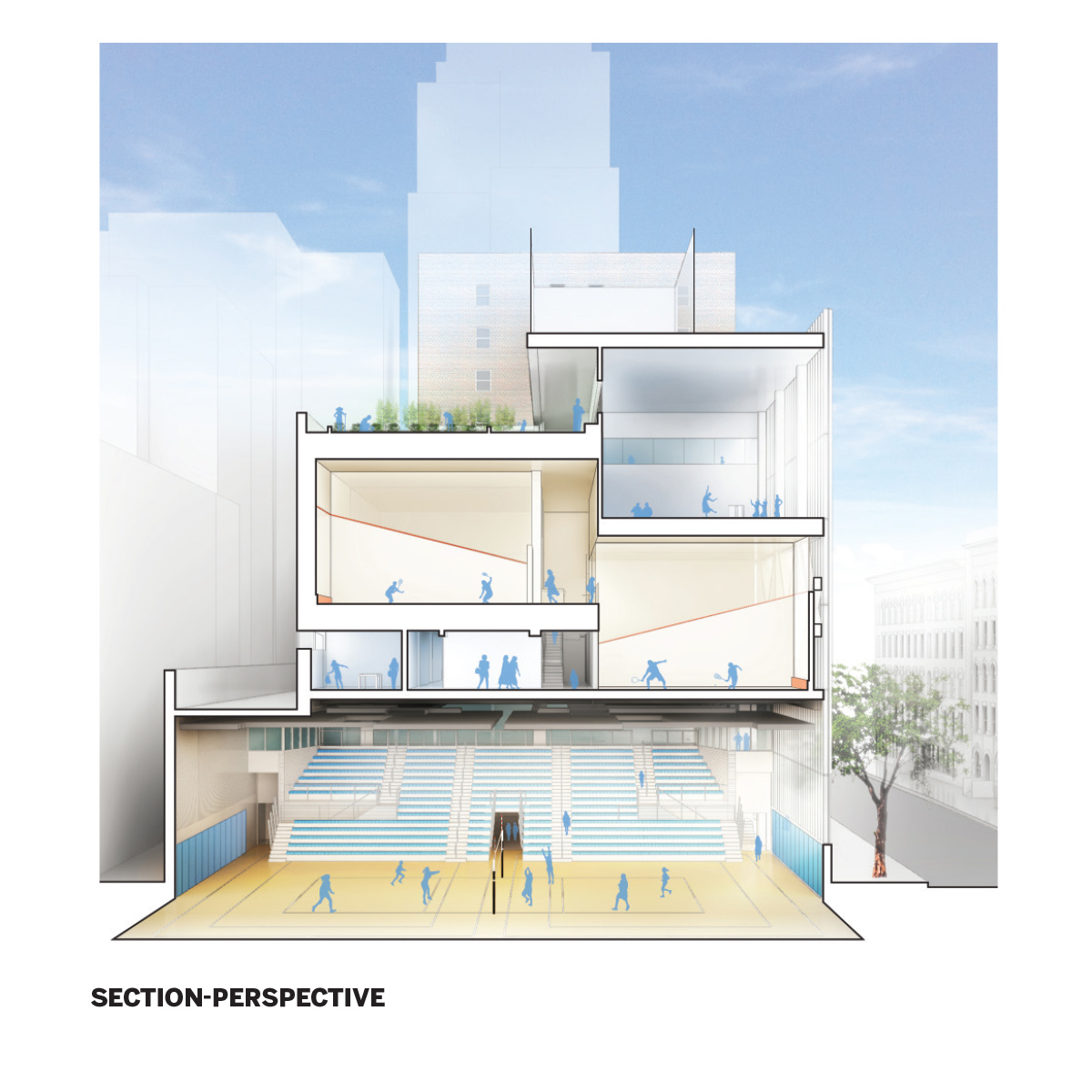
Photography by Albert Vecerka
Credits
Architect: Rogers Partners Architects and Urban Designers
Engineers: Langan (civil and geotechnical); Thornton Tomasetti (structural); ICOR (m/e/p)
Consultants: Jaffe Holden (av/acoustics); Front (envelope); Nelson Byrd Woltz (landscape); Tillotson Design Associates (lighting); Thornton Tomasetti (sustainability)
General Contractor:
Gilbane (construction manager)
Size: 59,200 square feet
Cost: withheld
Completion date: January 2021
Sources
Rainscreen: Kingspan
Fiber-reinforced concrete panels: Equitone
Masonry: Westbrook Concrete Block
Roofing: Siplast
Glazing: Saint Gobain; Wasco
Doors: Kawneer; United States Bulletproofing
Interior finishes: Armstrong World Industries; Porcelanosa; Laticrete; Tretford
Rubber tile: Roppe
With École Les Coteaux Fleuris, HEMAA Architectes and Hesters-Oyon Create a Local Attraction
BY ANDREW AYERS
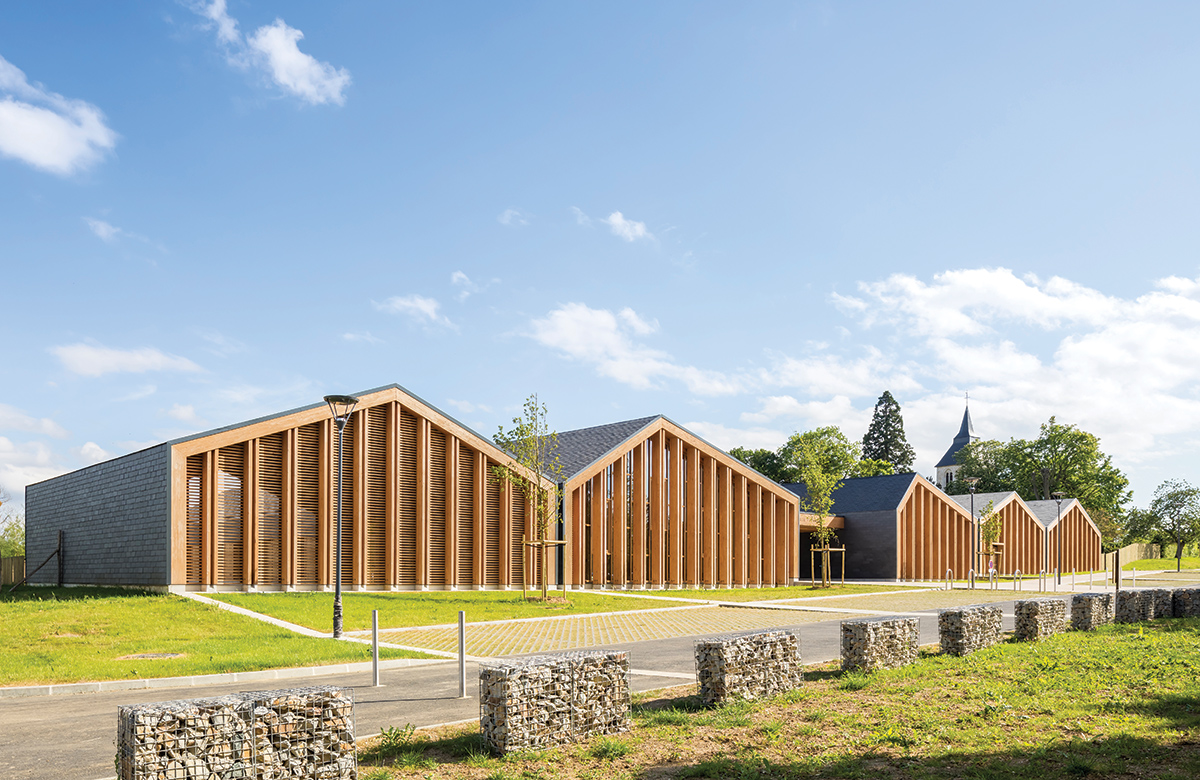
Photography by Sergio Grazia
The École Les Coteaux Fleuris.
“We may be tiny, but we’ve made other places in the region jealous,” proudly declares 80-year-old Hubert Zoutu, mayor of Heudebouville in southern Normandy, a village of 800 souls in the Seine Valley. The reason for their envy? Heudebouville’s splendid new school—a $4.7 million, 17,000-square-foot facility that replaces a cramped, inadequate jumble of buildings dating back to the 19th century. “What’s more, it was a team of young architects who built it,” continues the mayor, referring to Charles Hesters and Pierre Martin-Saint-Étienne, both 34, cofounders of the Paris-based office HEMAA, who won the December 2018 design competition with a little help from Charles’s architect parents, Jacques Hesters and Brigitte Oyon (of Hesters-Oyon, also in Paris). “My parents had too much work, so we offered to do the competition design,” recalls Charles. “They have a lot of experience with schools, and corrected a couple of things here and there, but the project was ours. We hadn’t yet founded HEMAA, so it was submitted in their name, but we oversaw construction after setting up our office.”
Located on a (literal) greenfield site, in the shadow of Heudebouville’s 13th-century church tower, the École Les Coteaux Fleuris takes its cues from the context. Under the village’s planning regulations—recently updated with environmental concerns in mind—earthworks must be kept to a minimum, which ruled out major excavation or embankment of a site that slopes gently in the direction of the Seine. Consequently, in a layout reminiscent of medieval strip farming, HEMAA organized their building as a series of parallel wings, each slightly lower than the previous one as they descend the hill, linked together internally by a long hallway (the only place inside where the slope is perceptible). In a growing village—population is expected to reach 1,000, due to the presence of a nearby industrial zone—this arrangement also has the advantage of allowing future enlargement. While the school is dimensioned for 150 pupils (it currently counts 93), its wings could easily be lengthened, in the case of greater population growth, without disturbing the functioning of the existing parts. “We already put in some of the drainage for that,” explains Hesters, “and registered the school with the fire authorities as bigger than its current capacity, so as to ensure a smooth transition when the time comes.”
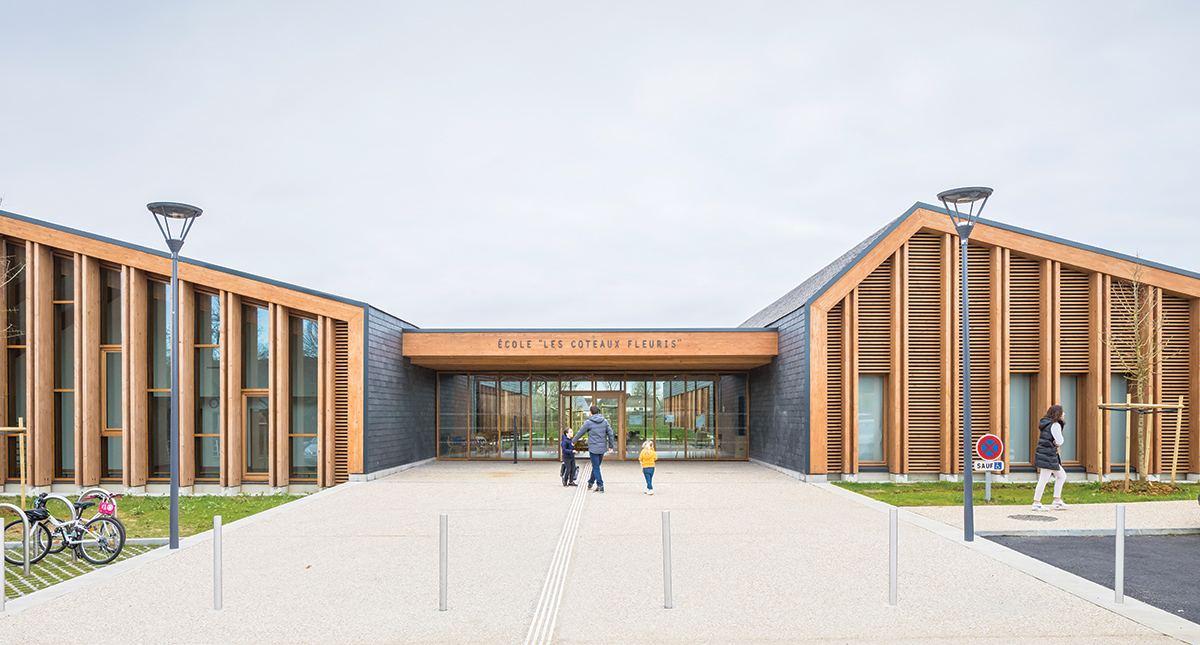
Photography by Sergio Grazia
Built on a greenfield site near a 13th-century church tower (top of page), the École Les Coteaux Fleuris (above) takes cues from its context.
Again in response to context, the wings take the form of archetypal pitched-roof volumes that recall both traditional French longères—long, narrow farmhouses—and Norman barns. “The client asked us to respect strict environmental standards, which meant we had to watch our embodied carbon,” says Hesters, referring to the CO₂ emissions associated with materials manufacturing and construction. “That ruled out concrete. We could have used rammed earth or hemp bales, but instead we chose wood, since traditional farm buildings in the area are built using timber frames.” Two varieties of structural timber have been employed, both sourced in France: weather-resistant Douglas fir for parts exposed to the elements, and cheaper pine for those that are not. The glulam gable frames were prefabricated off-site, as were the insulated wooden facade and roof panels, allowing quick and easy mounting of the shell. Moreover, just as traditional timber buildings sit on a masonry base, so the École Les Coteaux Fleuris is set above the damp ground on a plinth of prefabricated concrete blocks, which are themselves bolted into the site-cast foundations.
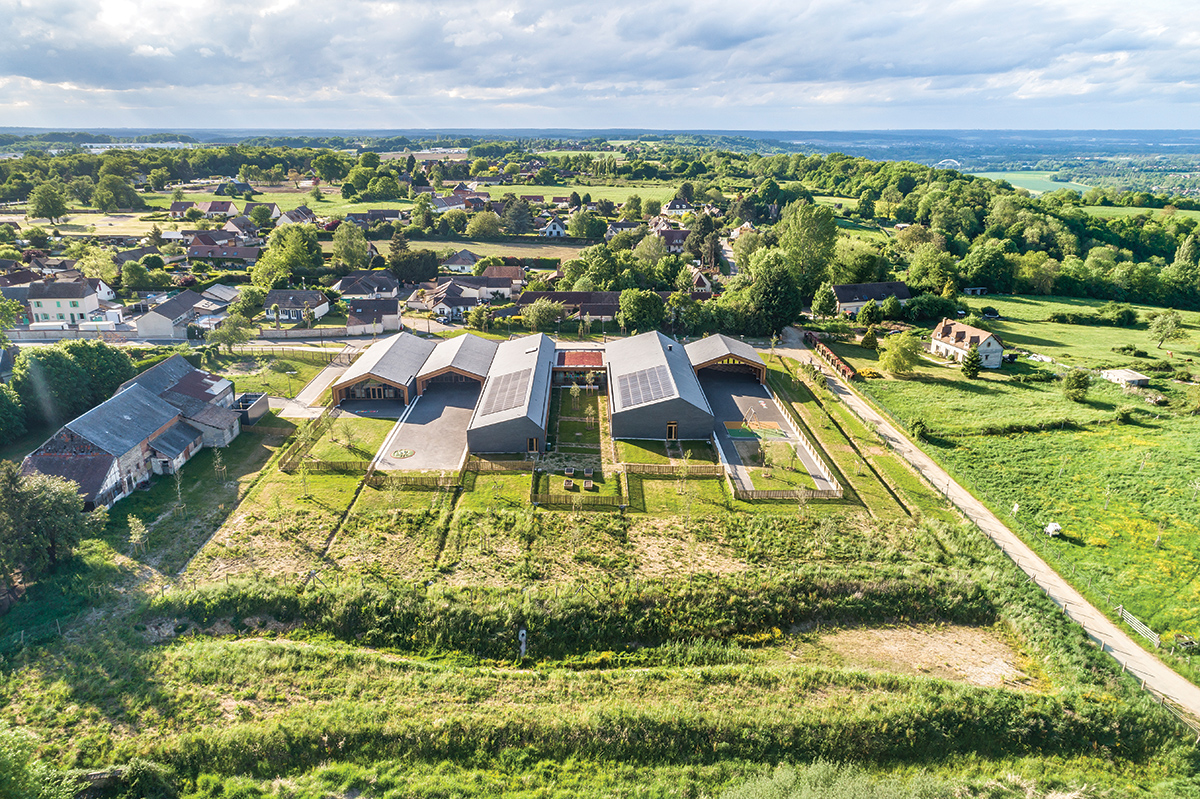
Photography by Sergio Grazia
At home in its rural setting, the school resembles the area’s traditional farmhouses, and has ample open and covered outdoor playgrounds (below).
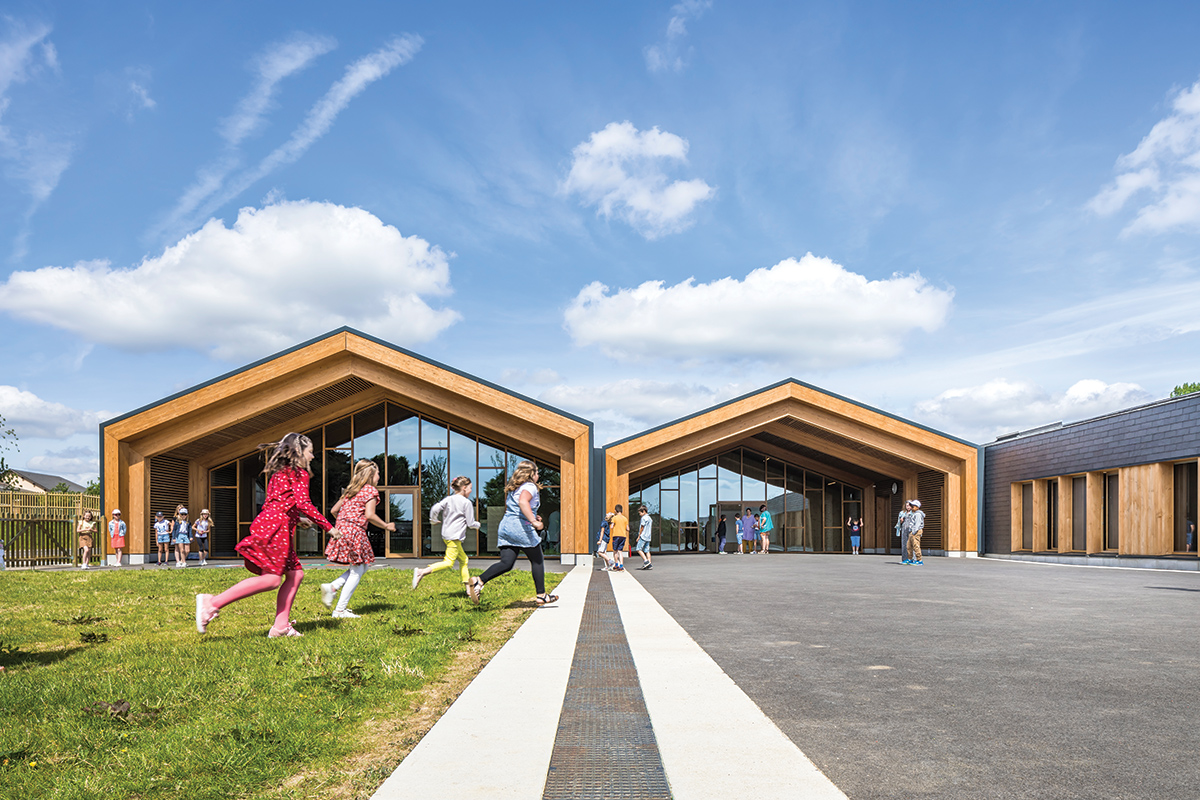
Photography by Sergio Grazia
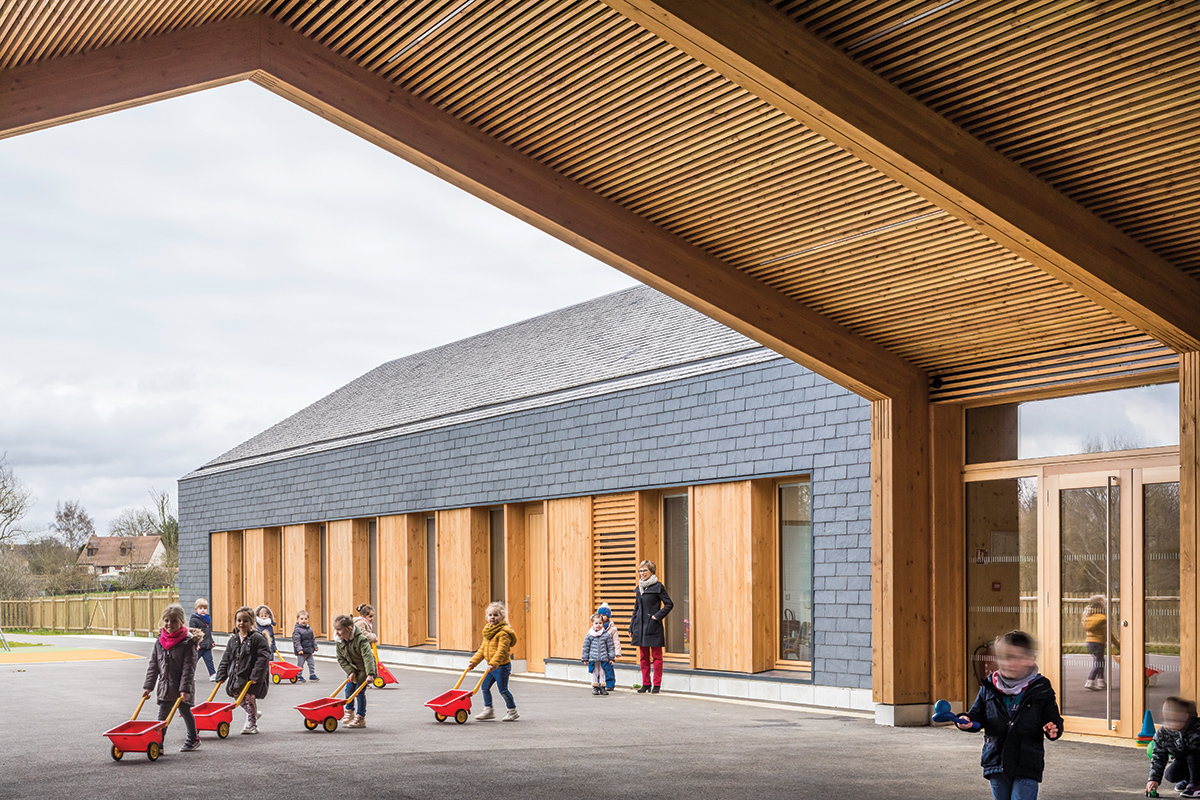
Photography by Sergio Grazia
For the roof, HEMAA chose hard-wearing low-carbon slate, traditionally a noble material that was used for châteaux (such as nearby Gaillon, the summer seat of the bishops of Rouen) and churches, like the spire at Heudebouville. As well as being contextual, this choice embodies the high-minded, official nature of French schools, which are viewed as frontline ambassadors of the secular, centralized state. To their dismay, the architects discovered that slate is now hard to come by in France, but found a competitive supplier not too far away, in northern Spain. Slate also harmonizes with the 2,500 square feet of roof-mounted solar panels—intended to make the school energy positive by providing more electricity than is needed to run it—while an air- and water-sourced heat pump avoids recourse to fossil fuels. A system of ground-level gutters channels rainwater into a reservoir, which feeds the school vegetable patch, thanks to a hand pump in the playground, the latter extending into a grassy orchard.
Inside, kitchens, administration offices, and the sports hall are lined up on the street, while the classroom wings (distinguished by their asymmetrical gable frames) project out to the rear. There are two of them—one for maternelle children (ages 3 to 6) and the other for élémentaire pupils (ages 6 to 11)—with classes accessed by long corridors, but also connecting in enfilade. Thanks to the wide-span frames—between 40 and 50 feet—all the interiors could easily be reconfigured in the event of a future change of use. While dropped ceilings hide mechanical ventilation in the classroom wings, the building’s structure is expressed in the two préaux couverts—outdoor shelters found in every French school, which allow playgrounds to be used in wet weather—and the sports hall, as well as in the dining hall, where ventilation ducts are also exposed. “Were we to do the project again, we’d encourage the client to get rid of the dropped ceilings and expose the structure and ducting everywhere,” says Hesters, gazing wistfully at the dining room’s warm, handsome all-wood volume.
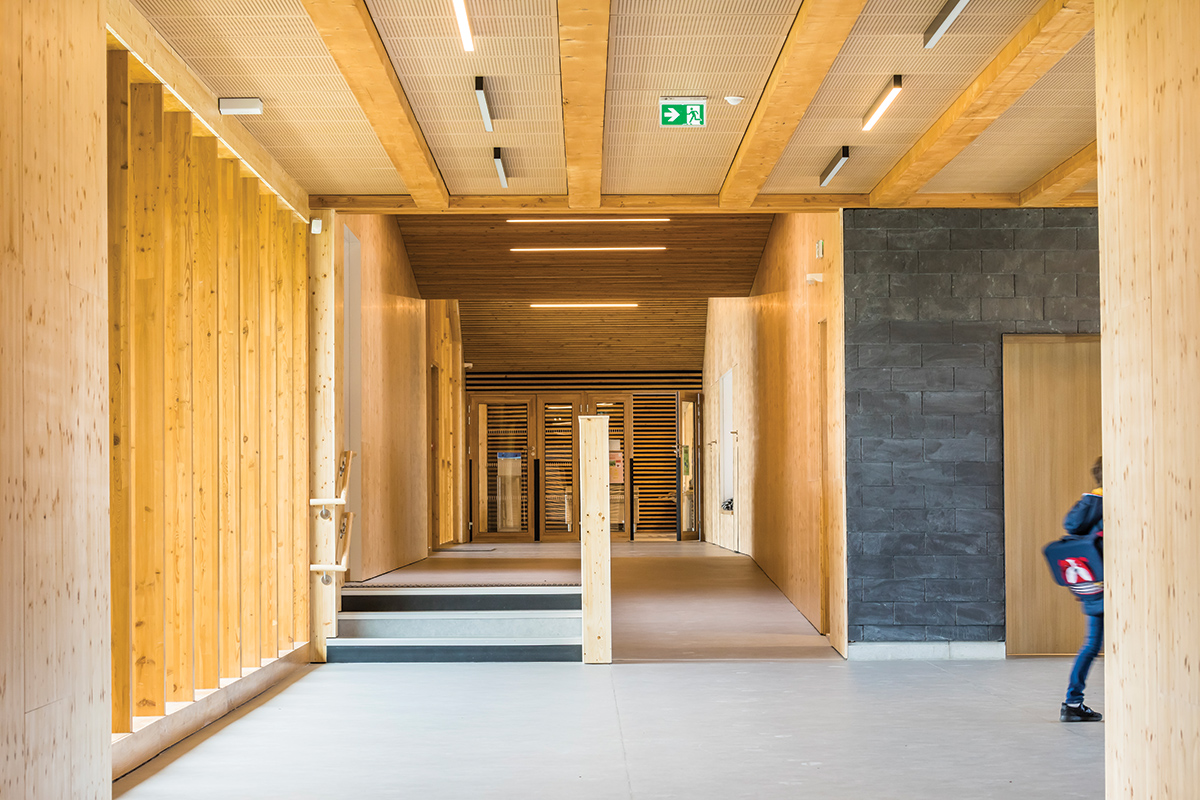
Photography by Sergio Grazia
A common lobby and corridor link the daylit wings, which house nursery and primary school classrooms, a cafeteria, and sports hall.
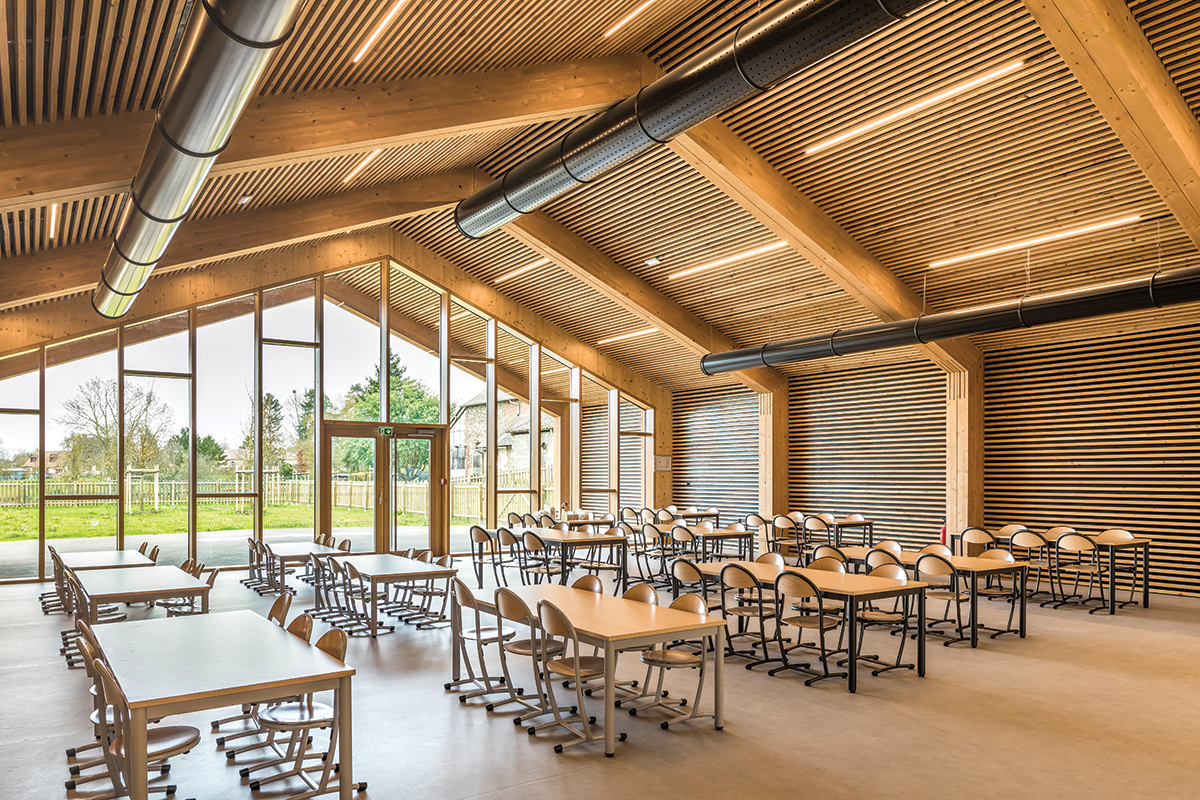
Photography by Sergio Grazia
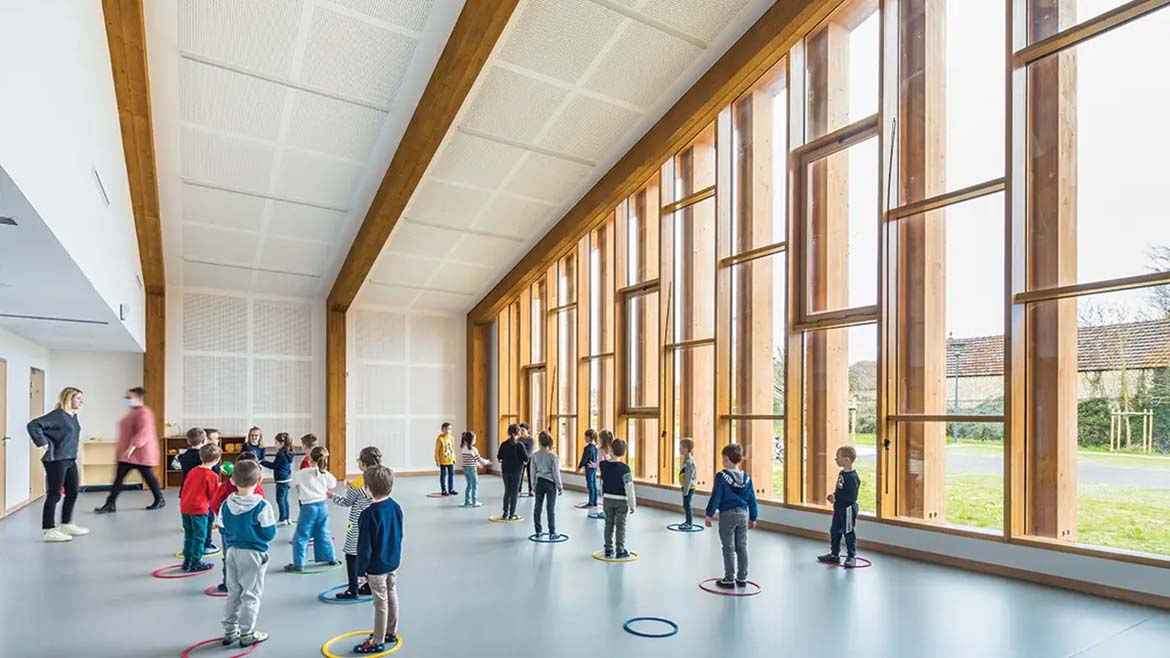
Photography by Sergio Grazia
Hesters and Martin-Saint-Étienne poured a lot of energy and enthusiasm into this, their first big project, and you can feel it in the attention to detail, from the design of the metal gutter covers and windowsills to the way facade verticals (to which windows and wall elements are attached) elegantly double as brise-soleils, or the sleek dissimulation of the bolts holding the timber frame together. They are currently converting the old school buildings into a village sports hall, day-care center, and meeting space. “Once all this is completed, I can retire without feeling bad,” says Mayor Zoutu, who will turn 84 in 2026, when his third term in office comes to an end.

Photography by Sergio Grazia
Credits
Architect: HEMAA Architectes and Hesters-Oyon — Charles Hesters, Pierre Martin-Saint-Etienne, Jacques Hesters, Brigitte Oyon, design team
Engineers: BETEM (structural/electrical/ventilation); IMPEDANCE (acoustical); Tempo (scheduling/planning/coordination); Ciclop (project management)
Consultants: AGC Piemont (wood structure and facade); JPV (windows and doors); JOLY (slate); DeBiasio (foundation); SPIE (lighting); Bichot Enerxia (plumbing/hvac)
Client: City Of Heudebouville
Size: 17,000 square feet
Cost: $4.7 million
Completion date: February 2022
Sources
Slate: Cupa Pizarras
Taller de Arquitectura de Bogotá Wraps a Gym in an Accordion-like Facade
BY MICHAEL SNYDER
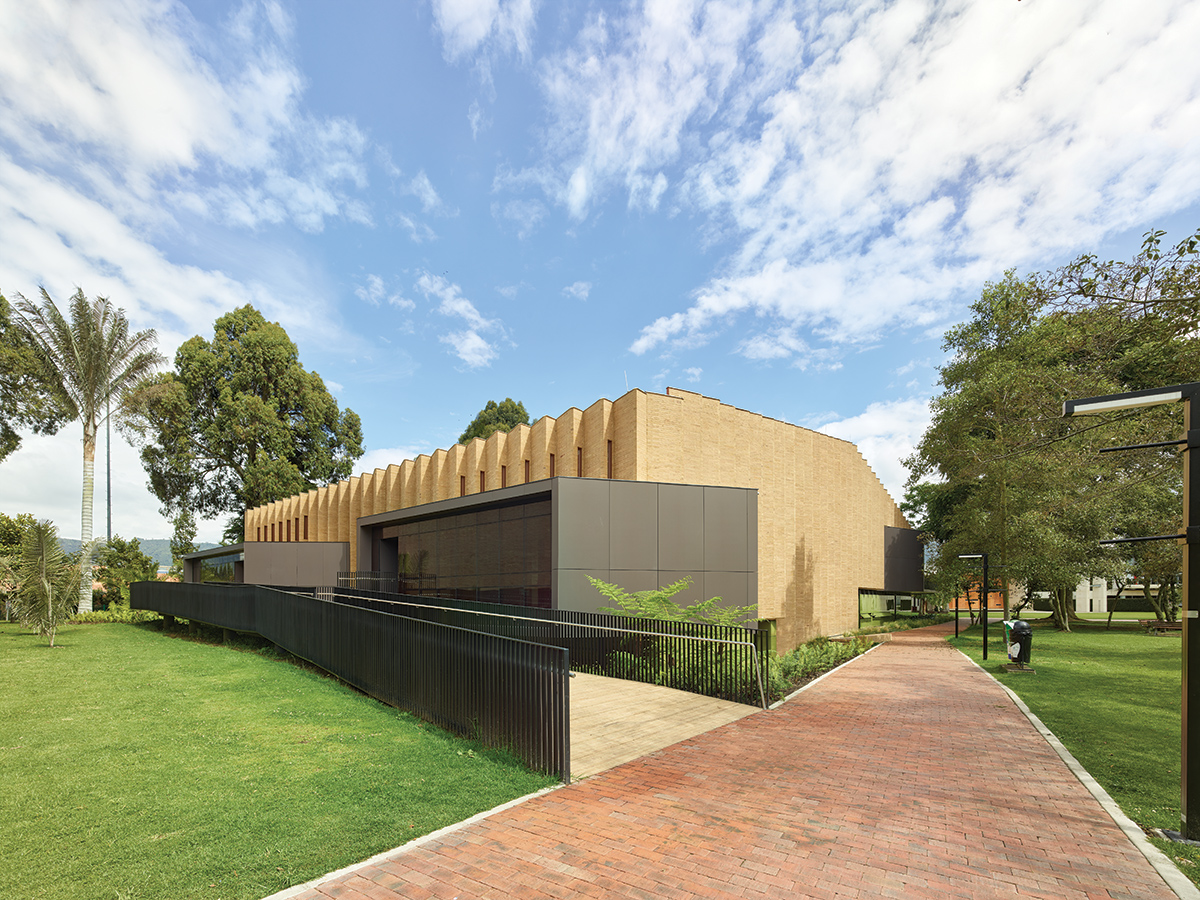
Photography by Roland Halbe
Sports and Culture Center, Colegio los Nogales.
In the context of a school, says architect Daniel Bonilla, principal designer at the Colombian firm Taller de Arquitectura de Bogotá, “architecture is the third teacher.” The first, of course, is the actual instructor, and the second is the curriculum. But the buildings in which they study, Bonilla says, “teach them how to communicate, how to relate to others, how to respect a space.” At the Colegio los Nogales, a private K–12 school at the northern periphery of Colombia’s sprawling capital, Bonilla’s firm has been collaborating on the school’s built environment for more than two decades, most recently in a dramatic renovation of the school gymnasium into what the institution now calls its Sports and Culture Center.
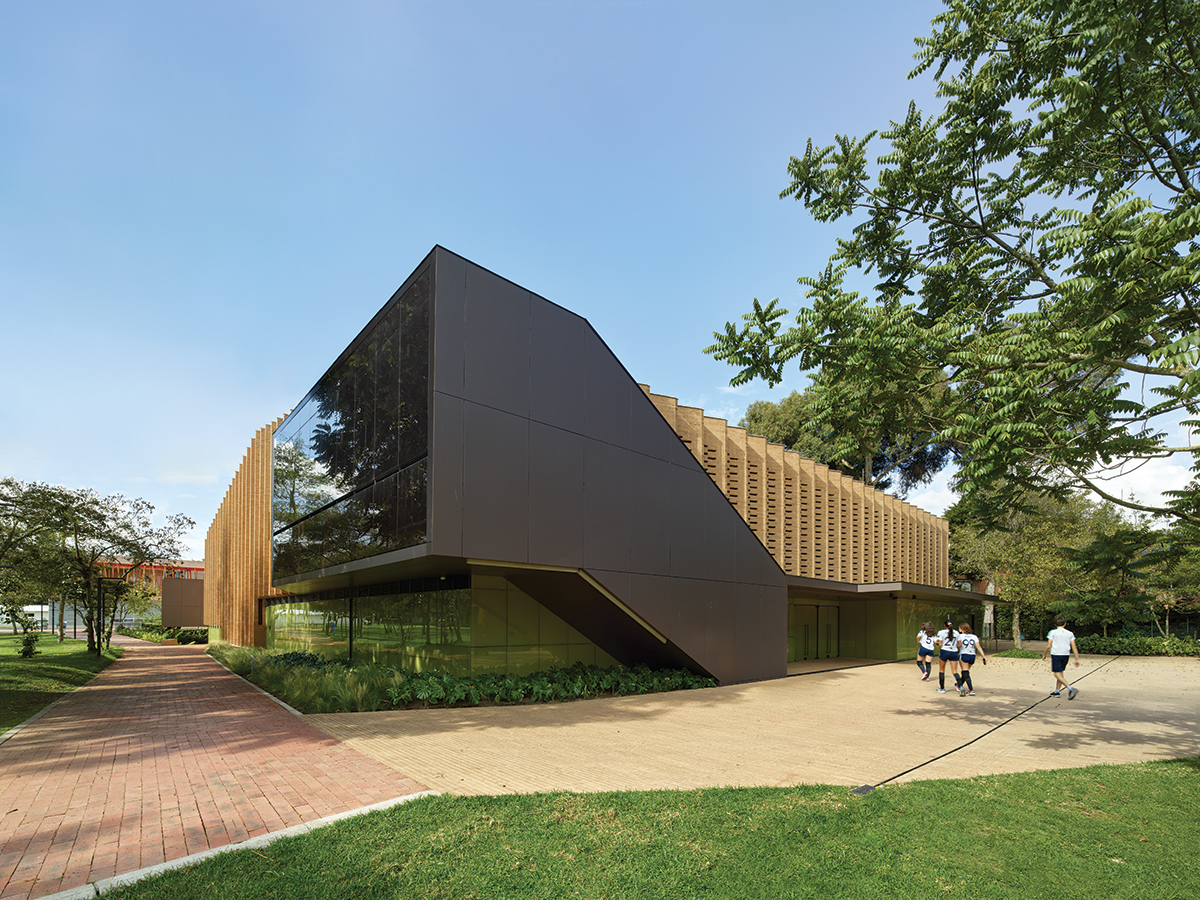
Photography by Roland Halbe
Appendages clad in coffee-colored panels (above and top of page) house programmatic elements that include a snack bar and dance studios.
The project, Bonilla’s seventh on the 33-acre campus, began with a basic requirement to update the old athletic infrastructure. Founded in 1982, the school shifted to its current campus in 1990. Original to that period, the gym needed a new floor to meet the rigorous standards of the Council of International Schools and the New England Association of Schools and Colleges, both of which Los Nogales follows assiduously. The gym had also been erected long before the passage of Bogotá’s most recent seismic regulations from 2010. The architects managed to make the necessary adjustments to the original steel roof trusses and concrete columns and beams, but reinforcing the walls would have been “such an invasive process,” says Bonilla, “it would have cost the same as knocking them down and reconstructing them.” Bonilla and his team therefore opted to maintain the structural system but rebuild everything that wrapped around the volume.
Bonilla took the existing building’s materials as a point of departure. The original structure had consisted, essentially, of four brick walls and a gabled roof, supported by the concrete columns and beams—little more than a warehouse over a wood-floored court. The renovated building, in accordance with the changing standards of competitive private institutions like Los Nogales, would need to provide multiple uses, with flexible seating, a stage for assemblies and performing arts, as well as auxiliary classrooms for aerobics, dance, and meditation.
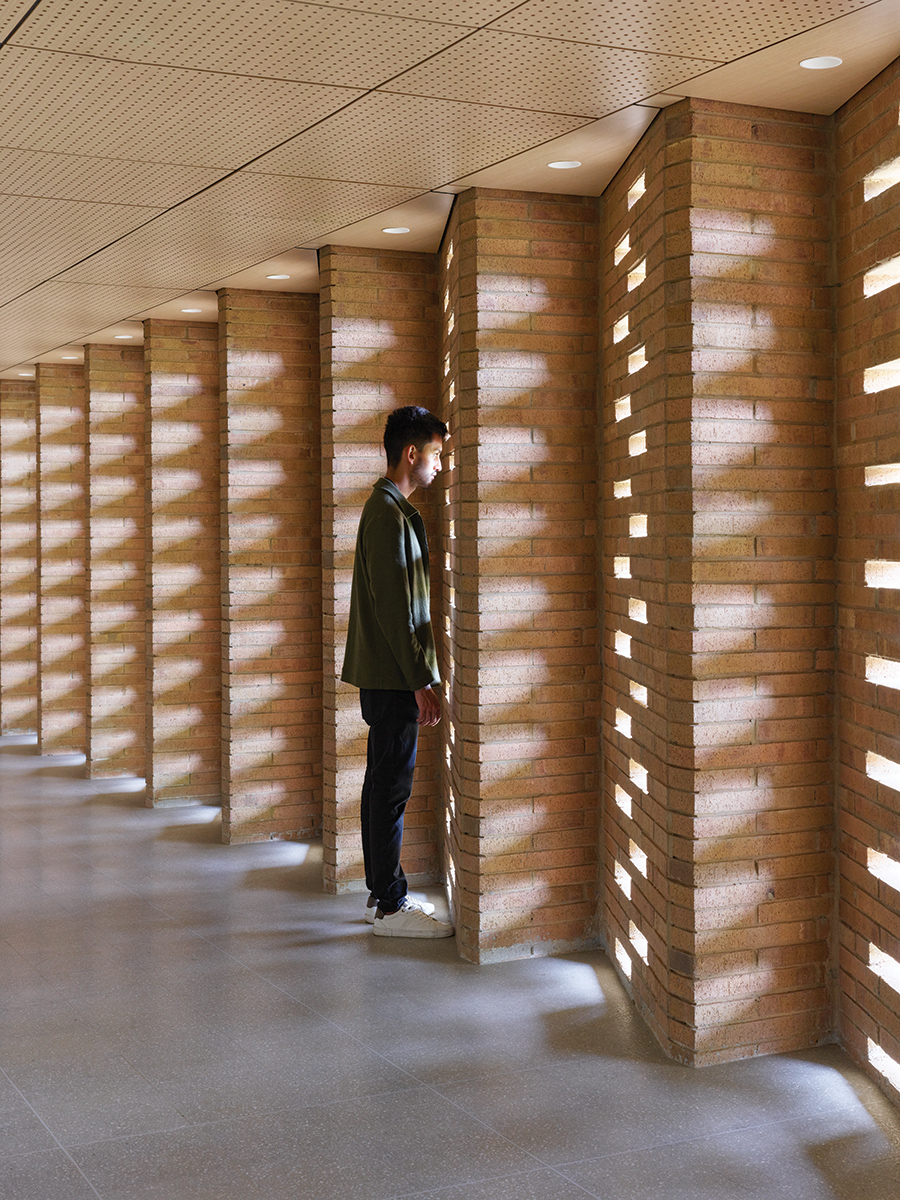
Photography by Roland Halbe
Inside, especially in an upstairs hallway, the pleats read as ribbing./p>
The first step, after making the mandated adjustments to the building’s basic structure, was to replace the four planar surfaces of the building’s walls with delicately pleated brick, an approach that created visual dynamism while lending additional rigidity to the non-load-bearing walls, in accordance with the seismic regulations. Seen from the building’s interior, particularly in the upstairs hallway, the pleats read as columns or ribbing, a visual trick exaggerated by the apertures in the masonry surface, which provide for both ventilation—essential in any sports facility—and the infiltration of daylight. The choice of a pale, sand-colored brick, similar in tone to the maple gymnasium floor, envelopes the building in a warm, embracing monotone, ideal for Bogotá’s chilly montane climate, while the folded melamine-coated MDF acoustic panels that form the ceiling offer shifting glimpses of skylights and roof trusses, a delicate visual hide-and-seek in an otherwise prosaic space.
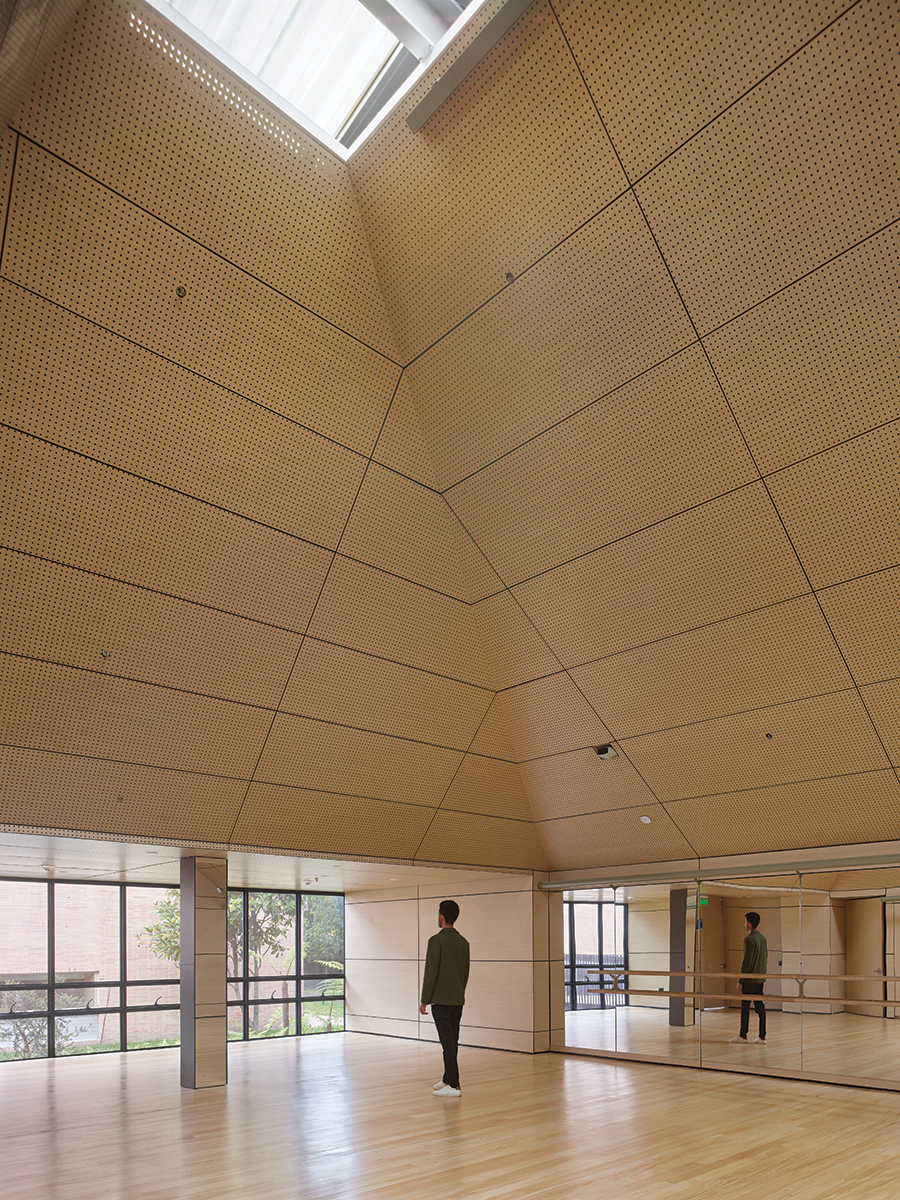
Photography by Roland Halbe
The dance studios rise to pyramidal skylights.
To contain the new elements of the program, Bonilla added external structures on the short ends of the building’s prism—“parasitic elements,” he calls them—cloaked in laminate panels the color of dark-roast coffee that “make these appendices really clear.” The addition on the southern facade contains a snack bar and circulatory spaces that connect the ground floor to the upper levels of the bleachers. On the northern end of the building, two projections cantilever out over a sunken garden of ferns and philodendrons. Facing the Center for the Arts, which Bonilla built in 2009, the rooms within each appendage function as annexes to the 2009 building and as a hinge between activities that many schools separate, sports and the arts. Inside, maple panels and mirrors for dance classes line the walls. The same panels rise on pyramidal vaults to skylights that fill the rooms with delicate, diffuse light. “When the kids come in here,” says Rafael Muller, the school’s physical education coordinator, “it’s like taking a deep breath.”

Photography by Roland Halbe
Gaps between the gymnasium’s folded ceiling panels offer glimpses of the roof’s structure and its skylights.
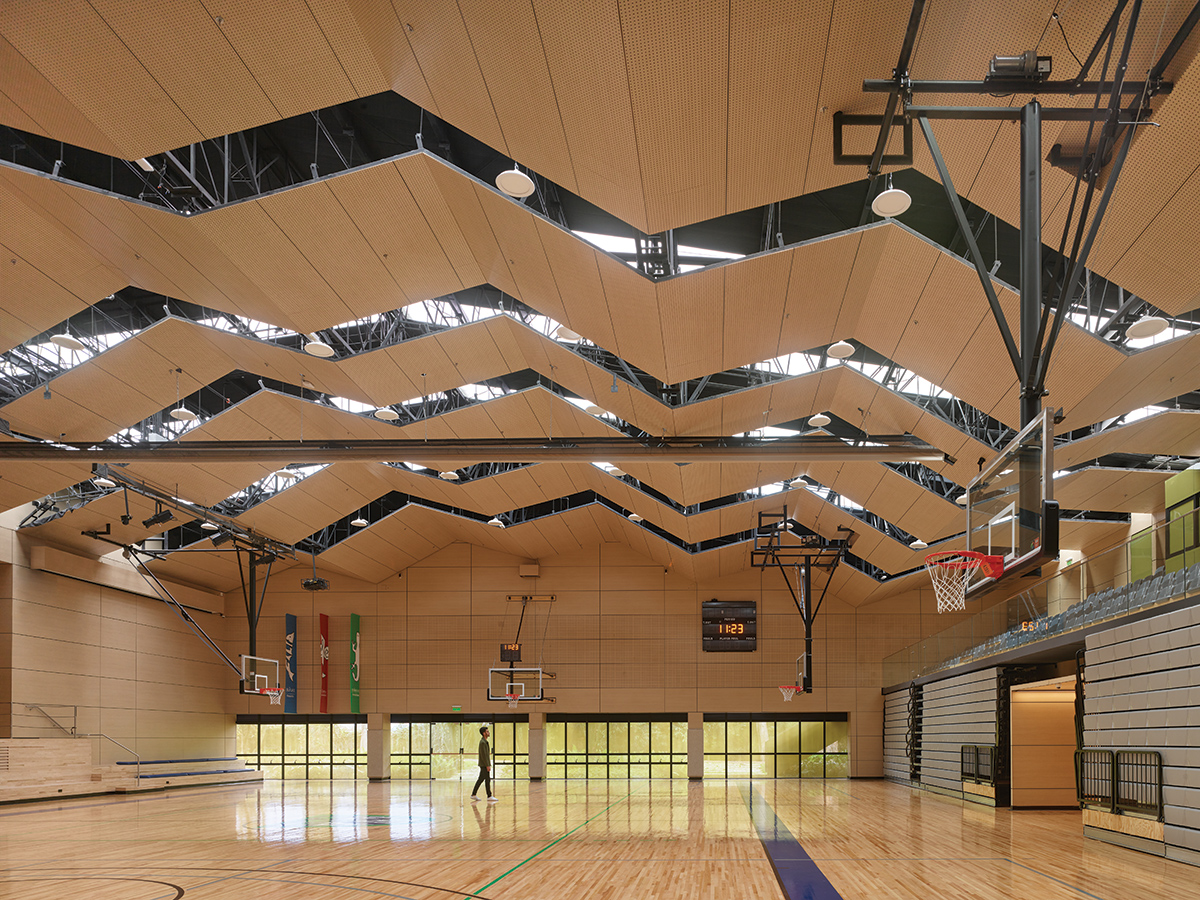
Photography by Roland Halbe
That sense of meditative calm has been essential to Bonilla’s work throughout the campus of Los Nogales, where his firm’s projects have included a library, cafeteria, administrative building, and a chapel whose lateral walls open out onto the central quad. Built principally with brick and concrete, the buildings are rich in secondary spaces—stairwells, inner courtyards, and galleries, where students gather to work and socialize between classes—but also minimal in their materiality.
"If everything we experience in the city is congested, loud, full of information,” Bonilla says, “then schools need to provide the opposite: austerity, sobriety, silence.” Leaving these spaces blank, porous, and adaptable also creates opportunities for students to invent entirely new uses, to interact in ways that adults—teachers and lawmakers and architects alike—can rarely anticipate. When it rains, as it so often does in Bogotá, the Center for Sports and Culture can become a playground. Teachers use it for assemblies. The student leaders, or “captains,” have appropriated the space for an annual dance competition called the Candelazo.
In its diversity and adaptability, the entire building resembles the circulatory spaces of Bonilla’s other projects at Los Nogales. Open to interpretation and experience, it is a civic education in itself. “The students love this space—everyone wants to use it for everything,” says Muller. “It makes you want to do things better.”
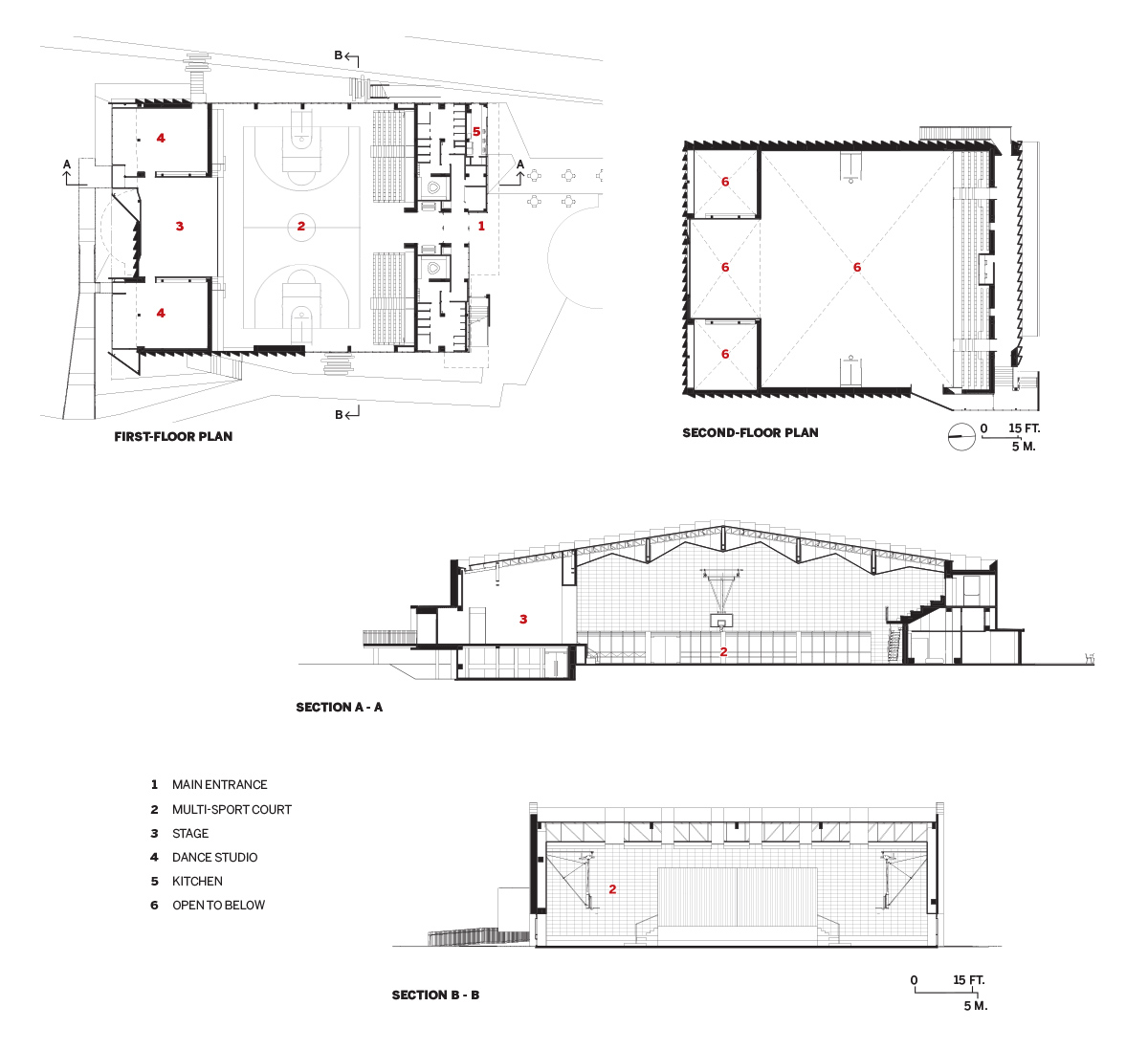
Photography by Roland Halbe
Credits
Architect: Taller de Arquitectura de Bogotá — Daniel Bonilla, Marcela Albonoz, lead architects; Cesar Grisales, Maria Alejandra Echeverri, Ixa Bachman, Andrés Gutierrez, Laura Bermudez, Mariana Carreño, Laura Gutierrez, team; Gabriela Barreto, Carolina Zapata, Angelica Ruiz, Santiago Gomez, Manuela Amado, Sebastián Rojas, interns
Consultants: P&D Proyectos y Diseños (structure)
Project ManageR: Vallejo Construcciones
Client: Colegio los Nogales
Size: 25,500 square feet
Cost: withheld
Completion date: November 2021
Sources
Masonry: Ladrillera Santa Fe
Windows: Rafael Perez Arquitectura
Gymnasium Flooring: Bi-Power
Lighting: High Light
Doors: Formica


























































